30 Of The Best Travel Friendly Instruments
Do you like to play a musical instrument while traveling? You probably wonder what the most travel-friendly instrument is. I’m here to help you out! And created this unique list of the 30 best travel-friendly instruments you can easily take with you while traveling. Let’s check it out!
When you think of an instrument you can take with you while traveling, most people think of the Ukelele. A thought I completely understand since I’m playing on my Ukelele all the time and bring it almost everywhere while traveling.
A Ukelele is a small string instrument, most of the time with 4 strings. The Ukelele is not only perfect for traveling because of its size. Also, it’s an original Hawaiian instrument with a unique tropical sound. Playing the Ukelele brings you directly into a vacation and traveler’s mood.
Playing the Ukelele is relatively easy. Once you learn the basic strumming patterns and some different chords, you can easily learn to play hundreds of other songs.
Keep in mind, though, that the Ukelele comes in different sizes. The smallest Ukelele, known as a ‘Soprano Ukelele,’ is 53cm (20 inches) long on average and perfect for taking with you for traveling.
Other sizes are a Concert Ukelele, Tenor Ukelele, Baritone Ukelele.
The longer the size, the lower the sound on the Ukelele. But also, it’s easier to play chords on a longer Ukelele when you have large hands or long fingers. That’s the reason why I prefer to play the Tenor Ukelele. I can easily place my fingers to play the chords and maintain that unique Hawaiian sound. Still, I bring a Soprano Ukelele with me most of the time while traveling; just because it’s so small, it doesn’t take up much space.
Do you want to buy a Ukelele for traveling? You can find the latest prices here on Amazon .
The Kalimba is originally an African instrument, also known as Mbira. It’s an instrument that belongs to the Lammelophone instruments. You’ll find variations of this instrument all over the African continent in different sizes, shapes, and amounts of keys.
On average, the Kalimba has 12 keys mounted on a wooden soundboard. Since it’s an instrument you play by hand, the wooden soundboard is small so that you can easily hold it. You play the keys by strumming the ends with your thumbs or index finger.
We use the Kalimba to play relaxing melodies and sometimes existing songs. The Kalimba is often small and easy to carry on, with an average size of 12cm (5inch) by 17cm (7 inches).
Some kalimbas are very expensive, but these are often used for professional use or made of unique wood. I recommend buying a cheaper one since you’ll take it with you while traveling. You can quickly get cheaper, and good-quality Kalimba’s on Amazon (check out the latest prices).

3) Harmonica
When I’m thinking of a harmonica, I always get that gypsy travelers vibe, you know what I mean, right? A harmonica is a perfect travel instrument since it fits right into your pocket.
Learning to play the harmonica is straightforward, but it can take some time to truly master the technique. Once you get that under control, you can easily play all kinds of rhythms you like.
The harmonica, also known as a mouth organ, is smaller than your pocket and weighs almost nothing. As I said, it is relatively easy to learn. The most important thing is that you learn to control your breathing since the instrument is played using your breath (inhaling vs. exhaling).
Find out the latest prices for a traveling harmonica on Amazon .
4) Hang Drum
Oh boy, this one is on my wishlist! I played a hang drum only once during a meditation retreat, and I’ve been hooked ever since. A hang drum, also known as a hand pan, is originally a steel drum with holes or dents that create unique tones when touched.
The original hand pans can be quite big, so they are probably not the easiest to carry on while traveling with a backpack. However, if you’re traveling with a campervan or by car, it’s easy to fit somewhere between your luggage.
A hang drum is an instrument I would recommend to everyone. The only reason I didn’t buy one yet is that they can be quite expensive, and you really need to take care of them in terms of how to play and store them. And because I don’t always have enough time to play, I feel it’s not the right time to make such an investment.
It’s also something to keep in mind when buying a Hang Drum. If you find one below, let’s say 1000 euros, it’s probably too good to be true. The reason for this is that hang drums or hand pans are created by hand. So it costs a lot of work to make a quality instrument like this.
For this reason, I recommend physically visiting a store to try out different drums. Tones, Feel, and how you play differ per hang drum. So you truly want to try it out first before making an investment.
5) Steel Tongue Drum Pan
This instrument is similar to the earlier mentioned Hand Pan. However, it’s smaller and cheaper. Also, often you play this instrument with sticks instead of your hands.
Actually, the only way you can compare it with an original hang drum is that both instruments are drum instruments and round. A Tongue Drum is a completely different instrument but still fun to play! And for most backpackers much easier as a carry-on instrument since it’s much smaller.
A tongue drum is also easier to buy since prices vary between 50 to 250 euros. It makes it an easy instrument to buy online and try out. Find out the latest prices on Amazon here.
6) Mandolin
The Mandolin is a travel-friendly instrument because of its size. Most Mandolins have an average size of between 13 and 16 inches.
Because the Mandolin has 4 double strings (8 strings in total), it’s often played with a plectrum (also known as a pick). Learning to play the Mandolin is more complicated than other string instruments like a Ukelele. It’s more difficult because of the double strings that are close together. However, it’s a beautiful and fun instrument to play once you get it!
Did you know Mandolins are often used in Folk music? A music genre that’s closely related to traveling! So, maybe the Mandolin is the perfect travel instrument because of this!
7) Folding Piano

Yes, that’s right, you can bring a piano while traveling and it doesn’t take up much space at all. Let me tell you more!
A folding piano is perfect when you love to play the piano. On average, and when folded, the piano is only 33 centimeters (13 inches). The piano is very lightweight and weighs only 1.6 kilograms! Best of all, you can play on 88 keys when unfolded, and it’s easy to use the built-in speakers or your headphone if you want to play in silence.
Since this piano is an electric version, you can easily connect it to your computer. Use or create your own samples or other things to create some unique music!
The battery can last up to 8 hours of playing time, which is perfect if you have to wait for a transfer while traveling or just being on the road.
I saved the best for last. It only costs you around 100 USD! Prices may vary. You can find the latest price here on Amazon .
8) DJ Controller
When you’re more into creating digital music, I got the perfect solution for you! A DJ controller can be a travel-friendly instrument to bring with you once you pick the right one. And that can be a difficult search process because many DJ Controllers are available on the market.
Keep in mind that you don’t have a lot of space for your luggage and instruments while traveling most of the time. So, the DJ controller must be small, easy to carry, and lightweight. Most DJ controllers are compatible with software on your laptop, smartphone, or tablet.
Depending on your preference and if you want to create, you can choose different DJ controllers perfect for traveling. However, the Hercules DJ control Starlight is a controller that is the ideal choice for many DJs. Easy to use and easy to fit in a backpack. Find out the latest price on Amazon.
9) Bongo Drums
“Drum drum away. It’s time for the Bongo to play!” I really love this instrument, especially when you really master it. The Caribbean vibes you get when someone plays the bongo drums always feel like a summer carnival!
Do you love to play Bongo Drums? To bring a set of bongo drums, it’s important to choose the right size. This way, you can easily carry the Bongo Drums with you while traveling.
This Bongo Drum set available on Amazon is perfect for traveling since its size is only 6 and 7 inches. It comes in an easy carry-on bag. Find out the latest price on Amazon .
10) Portable Cajon Box

Let’s stay in the drums for the following instruments. I really love to play the Cajon. It gives me almost similar vibes as the bongo drums. Also, it’s just so easy to play. You can literally dream away while playing on the Cajon Box. However, an original Cajon Box isn’t suitable for traveling because of its size.
Luckily there’s a perfect solution to this problem! Let’s learn more about the Travel Cajon!
A Travel Cajon has the size of a small tablet and comes in an easy carry-on bag. The size is only 29 by 23 cm (11 to 9 inches). The surface, made of wood, has two zones for bass and snare drum that are easy to play. Find out the latest price on Amazon .
11) Bluetooth Drum Kit

Traveling for drummers can be difficult since bringing a complete drum kit along while traveling is almost impossible. However, there are several options to bring some sort of drum kit with you to enjoy playing your favorite instrument.
Earlier, we mentioned some carry-on and portable drum instruments like the bongo drum and travel Cajon. But to play as a traditional drummer, you have some different options. However, the best option is the virtual reality drum kit from Aeroband. These drum sticks connect easily with your device via Bluetooth. The drum kit includes an 8 pad drum pad with two-foot sensors so you can easily play the bass drum as well.
The aero band drum set is best for travelers because it’s easy to carry on. All you need is your smartphone, tablet, or laptop to connect the drum set, and you can play your drums how you like them at home! Find out the latest price on Amazon .
12) Tamborim Drum

Bringing a classic tamborim drum is always fun while traveling. You can easily play some nice rhythms while on your own or relaxing with friends. But what I like most about this instrument is that it allows you to play along with other musicians you meet on the road.
A tamborim drum fits in most travel backpacks and suitcases. And if you buy one that includes a traveler’s case, you can always take it with you as a carry-on instrument.
Also, it’s one of the cheaper instruments to buy, and prices vary between 15 Dollars and 50 Dollars on average. The cost of a Tamborim drum depends on the drum’s material. Find your favorite Tamborim Drum on Amazon .
13) Traveler Guitar Acoustic
Some guitar players just can’t go without their guitar, so they always bring the instrument along while traveling. Depending on what kind of music you play and where you travel, you can decide to bring one of your more expensive models or find a cheaper one that is easier to carry on and also doesn’t costs much when it gets broken or something.
You really need to consider the way you travel so you can decide which instrument you bring with you. If you bring an acoustic guitar, make sure to also get a hard-top guitar case. Your acoustic guitar is much more protected for transport during traveling. Find out the latest prices on Amazon .
14) Traveler Guitar Electric
When you love to play Electric Guitar, bringing one with you can be a hassle since you always need to have an amplifier to play it. Luckily, electric guitars are available with built-in amplifiers, but these aren’t very good for advanced guitar players.
Your best way to go is to get a traveler model or just bring your good old electric guitar with a small traveler amp. For example, ‘the VOX amp plug is a great amplifier that can even fit in your pocket! You can find out the latest price on Amazon .
15) Melodica
This handheld instrument is perfect for bringing while traveling. A Melodica is similar to a pump organ and harmonica, but the difference is that a Melodica also has a keyboard on top. This gives you more possibilities to play different tones.
16) Recorder (Traditional Flute)
A recorder is easy to carry on Flute, so perfect for traveling. Did you know this Flute got its name all the way back in the 14th century? According to the stories, this Flute was used when students were trying to learn a new piece. Studying and learning were known as recording, hence the name.
A flute comes in different sizes and is made from different materials. But almost always, it will fit in your backpack or suitcase.
17) Pan Flute
Suppose you’re looking for a more traditional instrument that is easy to carry on. In that case, I recommend bringing a pan flute.
A Pan Flute is known as a traditional folk instrument. You can find them in different sizes and often they are made of a different material. However, for traveling, a standard size is more recommended.
18) Bamboo Flute
It might look like a recorder, but the Bamboo Flute is something different. Did you know it’s the oldest flute instrument ever found? Archaeologists found bamboo flutes more than 40000 years old!
And another funny thing, you can easily make it yourself!
19) Travel Digeridoo

I really love this instrument! Maybe because it brings me back to when we traveled to Australia. However, a traditional Digeridoo isn’t that easy to bring while traveling. But if you can go without one, you can always go for the Travel Digeridoo.
Yes, a small handheld variation of a traditional digeridoo that you can easily bring while traveling. Find out the latest price on Amazon .
You can always bring a flute when traveling. It’s easy to pack and always fun to play. We already mentioned different types of flutes that are perfect for bringing while traveling.
Find out which Flute you like to play the most before deciding which one to take on your next travel adventure.
21) Tambourine
Do you like to play rhythms? Bringing a tambourine can be a fun instrument for traveling. I feel a tambourine is especially interesting if you meet a lot of other people during your travels. If you like to play music with other travelers, a Tambourine always fits in.
You probably need an extra bag to bring this instrument, but if you like to play some rhythms, a Djembe is always a good idea. It’s perfect for connecting with locals because everyone always wants to play on the Djembe.
Find out the best Travel Djembe here on Amazon.
23) Concertina
I recently learned about this instrument and would love to play it once. It’s kind of a mini accordion, but also different. Because of its size, a Concertina is perfect for traveling.
A concertina is very easy to play and extra fun because it’s not a very popular instrument. So you’ll always meet other people while playing the concertina because many will be interested.
24) Mini Accordion
An Accordion is different from a concertina because of its size and that it also has a keyboard. Traditional Accordions are fairly big, so they are not ideal for bringing with you while traveling. However, you can always go for a mini accordion that fit’s in a small case or carry-on bag.
I really love the sound that comes from an Accordion. So, if you love folk music as well, I think you just found your favorite travel-friendly instrument. Find out the latest prices for mini accordions on Amazon.
25) Your Smartphone
Yes, you can easily use your smartphone as an instrument. And since you’ll probably bring one with you, it’s the perfect travel instrument if you love to create some digital music. However, the downside is that it’s very individual.
I don’t like using my smartphone all the time. When traveling, I feel it’s the worst device to bring constantly with you because it keeps you away from connecting 1on1 with fellow travelers or local people.
26) Orba Handheld Synth
Bringing a synth can be difficult when traveling because of its size. But a Handheld Synth is perfect because you can easily fit it in your backpack. Even better, it’s pocket size!
This unique design makes it perfect if you want to create some digital music along the road.
27) Plastic Saxophone
Are you a saxophone player? When you go traveling for a longer period, you probably don’t want to leave your saxophone behind. But there’s a solution! Probably not the most ideal if you are a more advanced player. Still, you can play your favorite instrument while traveling. Bring a plastic Saxophone!
Why plastic? Because it’s lightweight, easy to assemble, and if it gets broken or lost, it doesn’t cost you a fortune!
28) Plastic Trumpet

Yes, there’s also a plastic variant for Trumpet Players. It weighs less than 500 grams! Perfect lightweight instrument to bring while traveling. Again, it’s probably not the best instrument for advanced players, but it still allows you to play while traveling. Find out the latest prices on Amazon .
29) Midi Controller
Bringing a midi controller and your laptop or smartphone lets you effortlessly switch between (digital) instruments. Playing different instruments was never that simple, and it all fits in your backpack.
The only downside for bringing a midi controller while traveling is that it’s individual. You won’t be able to play music with other people since you’ll be focusing on producing music on your computer most of the time instead of going out there. Still, it can be fun to bring such an instrument and create awesome songs together when you travel with like-minded people!
30) Travel Violin
What differentiates a travel violin from a normal violin? I would say material and price. Regular Violins are often expensive instruments that you don’t want to bring while traveling around. Unless you are a professional musician and travel to play a concert or something.
If you just play the Violin as a hobby, I would say bring a cheaper one while traveling. It will always fit in a small carry-on case, which you can easily bring while traveling.
Recommended Articles
You probably found an instrument that you want to bring while traveling. You might be interested in reading one of my other articles as well. I recommend you start with What Inspires You To Travel?
Similar Posts
What inspires you to travel | 10 inspirational resources, is english widely spoken in portugal.

Jam Out With These Portable Musical Instruments Perfect for Travel
Whether you’re a prodigy or can’t find middle c, these packable music-makers will satisfy your inner troubadour..
- Copy Link copied

Like its guitar sibling, the new Klōs Carbon Fiber Ukulele is a serious instrument that’s seriously tough.
Courtesy of Klōs Guitars
Music is a universal language with the power to bridge cultural gaps and connect people from all walks of life. However, sharing music around the world can be difficult to do with full-sized instruments and astronomical baggage fees. Why buy an extra plane ticket for your harp if you could carry it in your backpack? Here are our top picks for travel-ready instruments to keep your inner musician happy when you’re on the road.
The Klōs Carbon Fiber Ukulele
Like the musician-acclaimed Klōs Carbon Fiber Guitar, the company’s new Carbon Fiber Ukulele is a professional-grade instrument that can stand up to pretty much any abuse. And because its carbon fiber shell stays stable even as temperatures and humidity levels change, you can go from plucking out “Tiny Bubbles” on the beach in Maui to strumming under the stars in Iceland with no change in sound quality. The best part—it weighs less than a grapefruit, making it effortlessly portable. Klōs offers acoustic and acoustic-electric versions. $439 (early bird price, via Indiegogo ); klosguitars.com

The Roli Seaboard Block Weighing in at just 1.43 pounds, the future of the keyboard has arrived and it has 5 Dimensions of Touch . The Seaboard Block contains a library of more than 200 sounds, allowing you to easily jump from the string section to a strong synthesizer in an instant. Express yourself from just your fingertips by using the soft, pressure-responsive surface that makes every moment of touch musical. One Block contains a two-octave playing surface; connect multiple Blocks or the Roli Beatmaker Kit for a true symphony of sounds. $300; roli.com

Courtesy of Roli
The Roland Aerophone AE-10 All you need are AA batteries to operate this first of its kind digital wind instrument. The Roland Aerophone AE-10 allows you to make music in any environment with an all-in-one saxophone, clarinet, flute, oboe, trumpet, and more. Practice quietly on an airplane with the headphones option, or perform with loud vibrato thanks to a fully optimized breath control and bite sensor. Weighing less than two pounds, this award-winning instrument is the perfect travel companion. $800; roland.com

Courtesy of Roland
Pearl Drum Travel Congas These travel congas by Pearl Drum are so lightweight and portable that you can even play them while hiking. A compact, 3.5-inch deep Remo Fiberskyn drumhead provides an outstanding tone while preventing fluctuations in sound due to shifts in temperature or humidity. You don’t have to be an experienced percussionist to make a beat on this lightweight instrument, and a Thai oak shell and polished steel hardware give it a snazzy look, too. $260–$280; pearldrum.com

Courtesy of Pearl Drum
The Gabrielle Harps Tranquility Harp Our most therapeutic instrument on the list, the Tranquility Harp by Gabrielle Harps is tuned to an ancient pentatonic scale in which all notes harmonize. The harp, less than five pounds, is handcrafted in Michigan to produce a heavenly sound that even nonmusicians can master. From children to patients in hospitals or retirement and nursing homes, anyone around the world will benefit from the peacefulness of this sound. The Tranquility Harp’s designer and maker, Jerry Ware, says there is no wrong way to play it: “You simply pick it up and play what you feel.” $450; gabrielleharp.com

Courtesy of Gabrielle Harps
>>Next: Tiwal 3 Is the Airline-Checkable Sailboat in a Suitcase


13 Small Musical Instruments (Super Portable!) to Travel With!
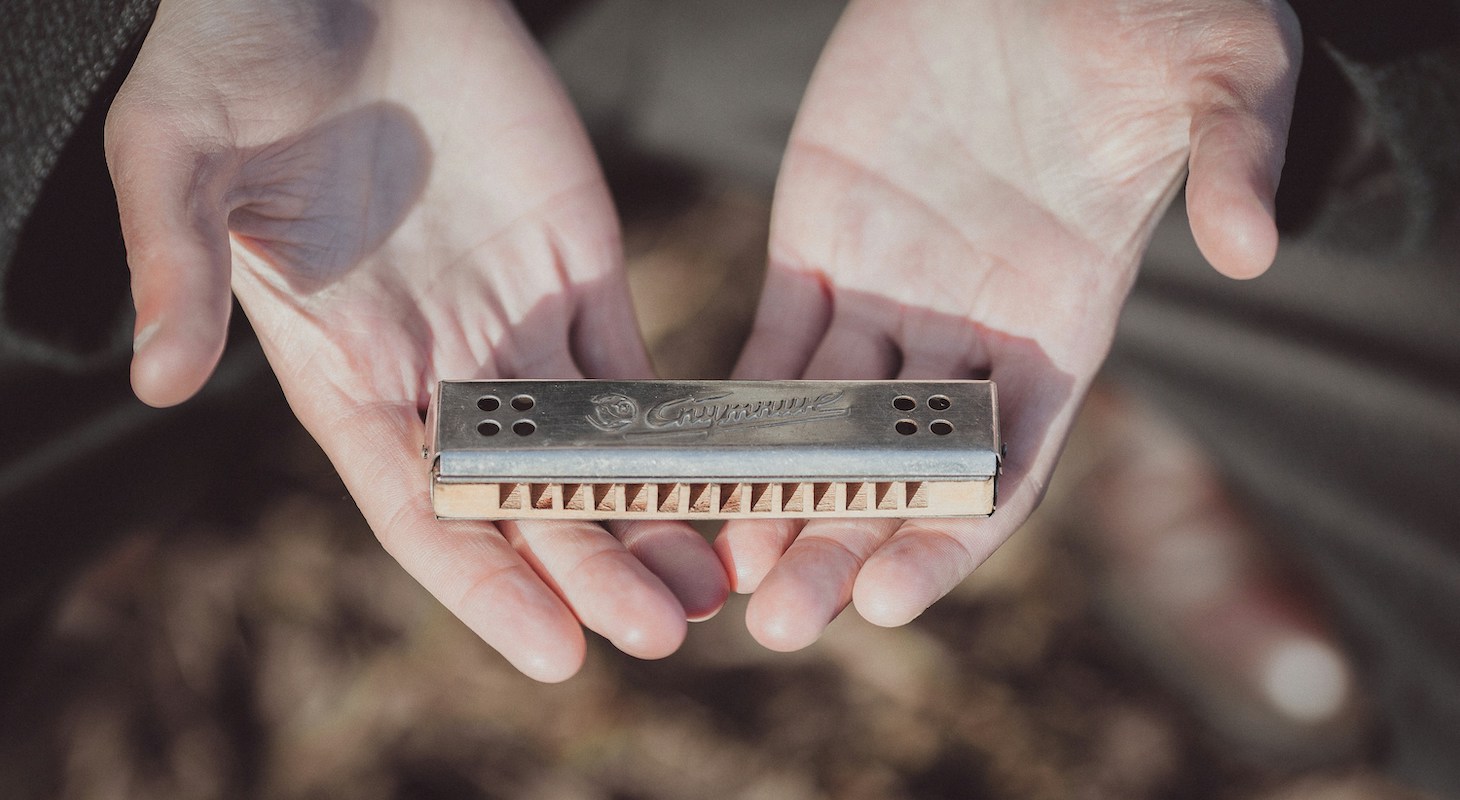
Jam sessions, especially the spontaneous and improvisational kind, are a sacred and universally revered ritual amongst musicians across the globe. Better yet, where spoken language fails to connect us, music can.
And where travel is already a deeply enriching endeavor, bringing the music with you adds a layer of connection to a place and its people that few other experiences can.
Unfortunately, bringing along your primary instrument or instruments may not be feasible, even if you’re only making a quick jaunt to a neighboring city. (Honestly, upright basses are straight-up human-sized.)
Not to be thwarted in our musical ventures, we’ve compiled a handy list of 13 portable instruments that are easy to travel with and fun to play!
Table of Contents
Travel Guitar
Melody harp, never leave home without one, portable strings.
There’s simply no substitute for strings, and thankfully, there is no shortage of travel-sized string instruments for players on the go.
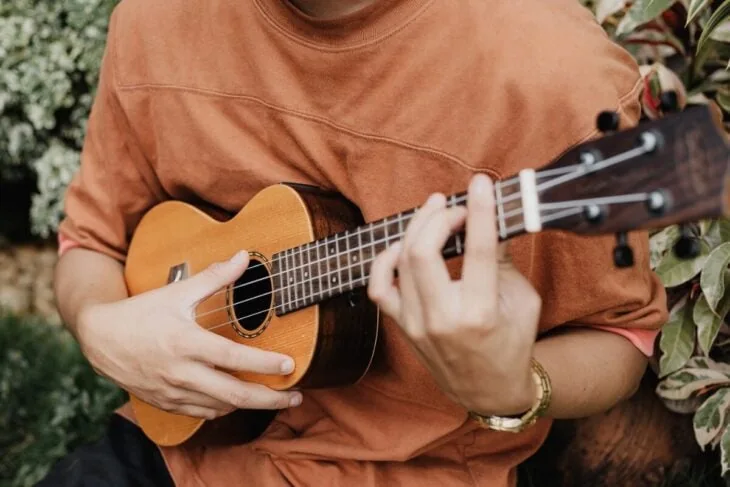
The four-stringed Hawaiian ukulele is beloved by many for its sweet, uplifting sound. Better than that, it’s compact and lightweight, and practically begs to be a musical traveling companion.
Plus, it’s a relatively easy instrument to learn and play . With just a few chords and some basic strumming patterns, you can start jamming in no time. Grab a soft, padded case to keep your ukulele safe during transport and hit the road!
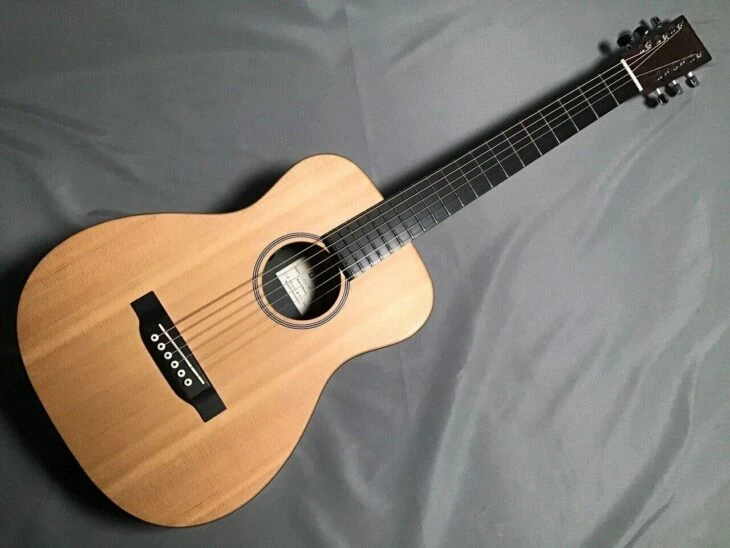
To the great gratification of wanderlusting guitarists everywhere, the realm of travel guitars is one marked by numerous choices and innovations.
The simplest travel guitars are just miniatures. But don’t let the “mini” moniker fool you. These pint-sized guitars can still pack a punch, and they come in a variety of configurations to dial in the playing experience you prefer.
For example, you can get a half-size body while keeping a wide fretboard with something like this mini from Cordoba . If you’re going all in on the mini experience (thin fretboard and all), even Martin has you covered with their ¾ size Little Martin , a favorite of Ed Sheeran. If the classic acoustic body shape is just too bulky for your adventures, try slimming down with something like this Martin backpacker mini .
When you just can’t compromise the volume and feel of a full size, consider a collapsible full-size guitar with a folding or detachable neck, such as this one from Journey Instruments .
Not to be outdone, electric guitar makers also offer travel-sized models such as this scaled-down version from Traveler Guitar or this collapsible electric also by Journey Instruments .
Ultimately, there is no shortage of guitar choices to satiate your inner road dog.
As the smallest of the classical viol family, the violin needs no modifications to travel well. And while many non-violinists may shirk at the thought of traveling with an instrument that is so difficult to play, remember that you’re not going to be sitting in with prestigious symphonies on the road.
Indeed, with a bit of study into scales and how to use the bow effectively, you may be surprised at how much you can contribute to an impromptu jam!
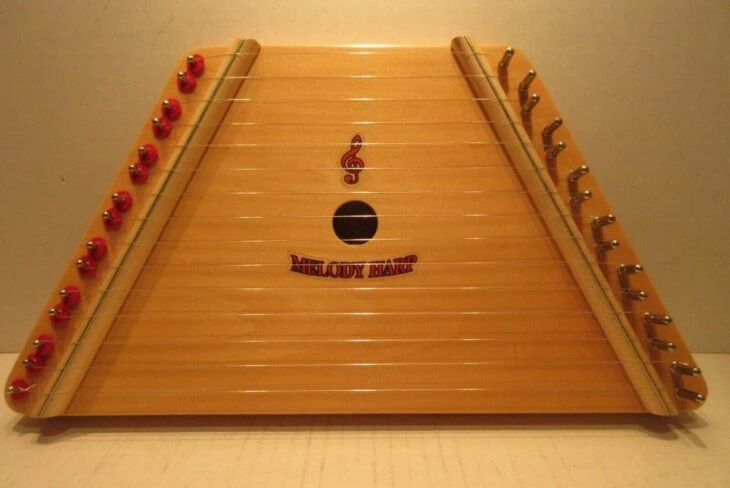
Like a compact harp for your lap, the affordable melody harp is oriented like a zither and generally has about 15 strings to play with. Truly — no technique required. Just pluck.
One benefit to the melody harp is that it is already tuned to a specific key, making it an extremely beginner-friendly instrument. With a basic understanding of notes, you can easily translate that tune in your head to the instrument in your lap. Anytime. Anywhere.
Handheld Instruments Of the Wind Variety
Some of these instruments are so small they can fit into your pocket …
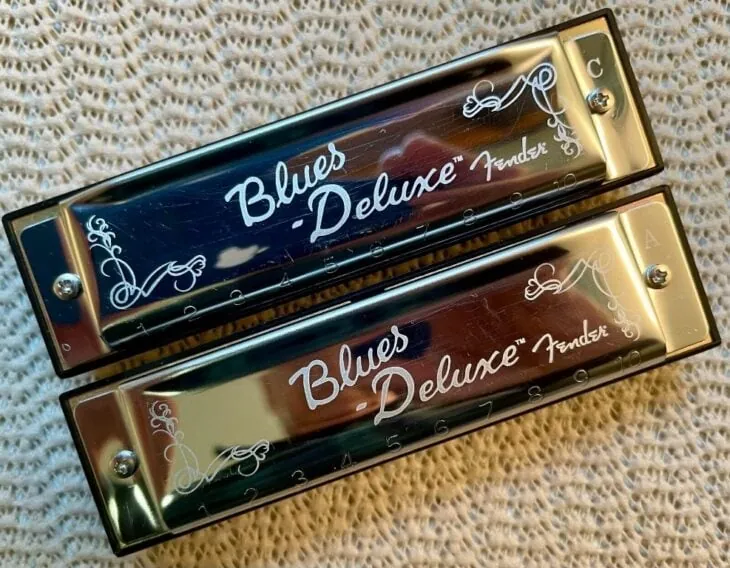
Few other instruments evoke the image of the quintessential American nomad more than the trusty harmonica.
A small, portable, and extremely affordable instrument that can be easily carried in a pocket or bag, the humble yet sturdy harmonica projects a strong, multi-faceted sound simply by blowing into it. It’s easy to learn, easy to transport, and lends itself well to a variety of musical styles.
Grab one by Fender , one of the most trusted names in instruments, and don’t leave home without it.
The sweet and haunting ocarina is a handheld, flute-like instrument with 12 holes and ancient roots. Traditionally, it is crafted in ceramic, but modern models may be made of plastic, wood, or bone. In any iteration, it is a durable instrument that stows away nicely in the pocket of just about any size bag.
In addition to meeting the size criteria for a highly portable instrument, the ocarina employs a very simple fingering system that is easy to learn and easy to play. It also ranks among the more affordable travel instruments. Pick up a simple one online to bring a unique sound to any foreign ensemble.
The tiny but mighty pan flute lends an ethereal feel to any soundscape and has featured prominently in cultures across the centuries. Best of all, it fits in your two hands and requires only your breath for power.
The learning curve is a tad steeper than something like the ocarina; but with some simple breath and technique exercises, you can be piping your way through simple melodies and rhythms in any setting. Plus, a simple pan flute such as this one is a durable choice that won’t bust your wallet!
Portable Percussion
When we think of percussion, we often conjure large, powerful instruments such as timpani, congas, and full drum kits. But traveling percussionists need not be left out of the party thanks to these super portable instruments …
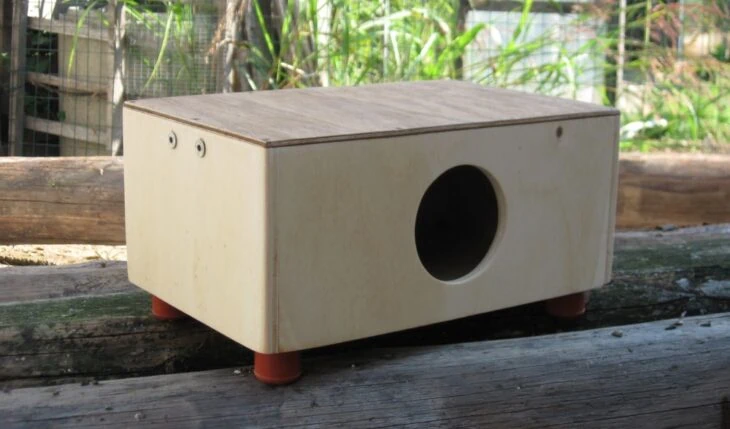
The unassuming cajon is a staple in acoustic settings and is almost instantly identifiable by the way it is played. Drummers sit on what appears to be a simple rectangular, wooden box and use only their hands to bang on the face of the box.
Behind the scenes, quality wood and a strategically placed sound hole help project sound while some cajon drums feature interior snares.
To be sure, they are cumbersome drums; but the mini cajon serves as a portable alternative for drummers on the go. While full-size cajon drums measure upwards of 20” in height, a travel-ready mini cajon such as this measures only 13”.
Be prepared to spend a bit on a good mini cajon as quality construction is what gives this drum its tone and presence.
The handheld kalimba, or thumb piano , does double duty as both a percussive and melodic instrument. Constructed of metal tines of varying lengths affixed to a small, wooden box, the kalimba produces distinct notes in addition to an iconic percussive twang .
As if the handheld size wasn’t already portable enough, mini eight note kalimbas can be worn around your neck.
While you may struggle to be heard in large ensembles, a quaint acoustic set abroad offers the perfect opportunity to contribute to both rhythm and melody during your travels.
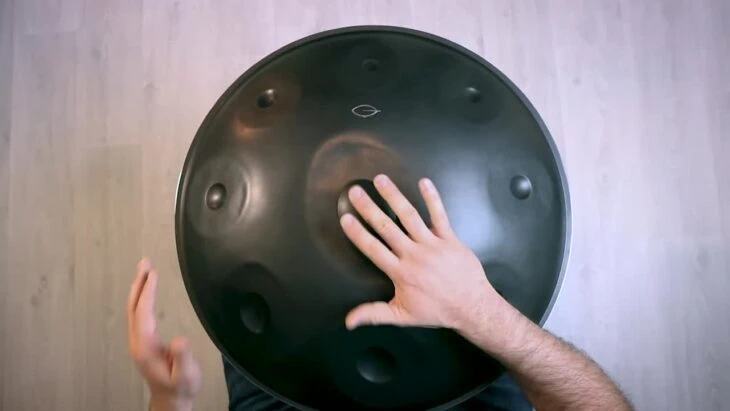
For a melodic drum that fits in your lap, look no further than the handpan.
If you’re not already familiar, that’s ok. The handpan is a relatively new melodic drum that lends a rather mystical, meditative sound to the mix.
Featuring one convex and one concave metal disc joined at a seam (think high hat but more pronounced and sealed together), the handpan’s tones come from carefully hammered-out dimples.
Most handpans feature one central note and eight complementary notes achieved by striking the drum strategically with your thumbs or fingers. The result is a gentle and hypnotic sound with deep sustain.
You may already be comparing the handpan to steel drums. They are not dissimilar; but handpans are lighter and smaller, making them much more suitable to travel with. Furthermore, handpans are relatively easy to learn and play, allowing you to hop right into the next drum circle you encounter!
Before you throw a pair of kitchen spoons in your suitcase, consider that professionally constructed musical spoons are designed to pack a much larger punch while taking up the same amount of space.
It is also worth considering that they are not as easy to play as one might think! Spend some time practicing basic rhythms and foundational techniques before busting these out at your next jam.
Note, too, that they come in a few different versions. Wooden spoons constructed as one piece, such as this model , set the folk percussion standard. But you can also play around with metal pieces, such as these , that look more like what might come out of your kitchen drawer.
Other Travel Instruments
Look no further for other portable instruments, some with keys and some you squeeze …
Weighing in at about 1 pound and measuring just 16” at its longest is the super rad and versatile melodica , the only keyboard you blow into.
With such a petite profile, the melodica practically begs to accompany you on your next adventure. And while a basic knowledge of piano keys is requisite, the learning curve is shallow. With a few lessons under your belt, you can rock the tiny 32-key piano-flute hybrid in a range of keys, playing both backing chords and melodies.
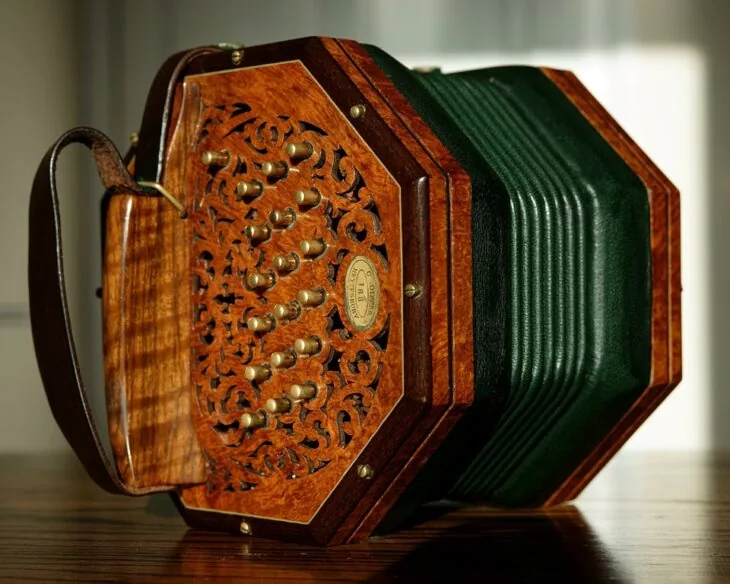
No jig is complete without the lively timbre of the accordion’s smaller cousin, the concertina.
In sharp contrast to the behemoth that is the accordion, the smallest concertina fits in your hands and doesn’t weigh but a pound or two.
Despite their super portable size, small concertinas, such as this one , are complex instruments with the price tag to show for it. Regardless of its complex construction, you can learn to play it competently in very little time. And with 20 keys to work with, you can play in numerous key signatures and octaves.
The concertina already enjoys a travel-ready reputation as Western European folk musicians considered it a staple of their nomadic ensembles. Indeed, any modern traveling musician can be equally proud to feature one in their set.
When music is as essential to you as eating, traveling with a small, portable instrument can be as important as packing your most comfortable walking shoes.
Fortunately, some of the smallest instruments can have the biggest impact on the quality of your travel experience. When music calls, you can answer, no matter how far you are from home.

About Alexis Ronstadt
Alexander Armstrong 10am - 1pm
Now Playing
Four Seasons Opus 8 - Concerto No.4 (Winter) (2) Antonio Vivaldi
Discover Music
10 tips for flying with your musical instrument
28 March 2018, 12:01 | Updated: 17 August 2021, 13:33

Flying with your musical instrument should be a smooth affair. To prepare for your flight, read these handy tips from the Incorporated Society of Musicians.
1. Check the airline’s hand luggage policy
Before flying, check the airline’s policy on hand luggage, and where possible, try to get written confirmation that you can take your instrument on board.
“We strongly recommend, where possible, that you contact the airline before you travel and receive written confirmation of the acceptance of instruments. Document everything and makes copies,” says the Incorporated Society of Musicians (ISM).
“ ISM members can obtain a letter from the ISM to confirm that they are a member and therefore work professionally as a musician and need to travel by air for work.”
2. Think about purchasing an extra seat
If you’re carrying an instrument larger than a guitar, like a cello , you should purchase an extra seat for it and ask for written confirmation that this is OK.
3. Pack your instrument in a hard case
Even if you’re taking it as hand luggage, flimsy instrument bags are a no-no. Get yourself a sturdy case to reduce the risk of damage.
4. Remove all other items from the case
“Make sure no item other than the instrument and its accessories are in the case,” the ISM advises.
5. Loosen the strings
If your instrument has strings, loosen them a tone or two to allow for temperature changes – this will ease any tension on the neck of the instrument.
6. Be prepared for your instrument to go through security
In an ideal world, your instrument would be touched by no one but you and your musically adept hands. But in reality, the security guards will probably want to have a look inside the case.

I Tried to Fly With an Instrument. Here’s What I Wish I Knew Before Booking.
I had it all planned. I was only going to take my backpack and my violin with me to France . It was my first time traveling with an instrument, so the day before my departure, I packed my music and made sure my violin, bows, and accessories were secured in my case. I went to bed confident in my preparedness.
My violin teacher, a professional musician, had assured me that I would be able to fly with my violin without any problem. That I could take it on the plane along with a small backpack for no extra charge. She’d done it dozens of times before. But in the middle of the night before the big day, I woke up full of doubts. I picked up my phone and checked the requirements for traveling with an instrument on Air Canada .
“You may bring your musical instrument on board as part of your carry-on baggage provided it meets the current Air Canada carry-on size requirements and: the instrument fits in the overhead bin or under the seat in front of you, or you purchase a seat to accommodate it.”
I had the sudden vision of my case not fitting inside the overhead bin (it definitely does not fit under an airplane seat). I verified the carry-on size requirements as advised, got out of bed to find a tape measure, and proceeded to check the dimensions of my violin case. It was too big.
There was no way I was going to chance it and take my violin on an eight-hour drive to the airport to find out I had to buy a seat for it or risk damaging the instrument by checking it. While seats for musical instruments on the Canadian flagship airline get a 50 percent discount, it was still an awful lot of money to spend at the last minute. So, I left my violin at home and hit the road.
It turns out that for many airlines based in the United States, taking an instrument along with you can be even more expensive than on Air Canada.
Traveling with an instrument on a US airline
If you travel with an instrument as a carry-on on American Airlines , you need to make sure it either fits under the seat in front of you or in the overhead bin. Since the size of overhead bins vary depending on airplanes, you’d need to check your ticket for the airplane you’re flying and then check the size of the bin of said airplane (an Embraer 170, for example, is much smaller than a Boeing 767). Start with the airline’s carry-on size restrictions and adjust from there.
Buying an additional seat for your instrument on American Airlines will cost you the regular adult fare plus any applicable taxes or carrier-imposed fees. Note that you can only buy a seat if the instrument is 165 pounds or less.
If you prefer to check your instrument or have no choice due to its size, you may have to pay the fee for checked luggage. Note that your instrument cannot exceed 25 inches high by 40 inches wide, or 25 inches by 38 inches if you’re flying in an Embraer 170, due to the minimum size of the cargo hold doors.
United Airlines
Traveling with an instrument on United Airlines follows roughly the same rules as American Airlines. The United Airlines website states : “You can carry a violin, guitar or other small musical instrument on board if it’s in a hard case. These instruments will count as a carry-on bag if placed in the overhead bin. If placed in the seat in front of you, they’ll count as a personal item.” Whether the lack of precise information means the crew will be more accommodating when you show up with your instrument is not immediately clear.
You’re required to buy a seat for “large or valuable musical instruments,” though there’s no indication of what “large” or “valuable” might mean in this case. Note that the seat must be booked in advance and you’ll pay applicable charges. In this case, the instrument cannot exceed 165 pounds.
Delta Air Line
On Delta Air Lines , guitars, violins, flutes, and small musical instruments are accepted as a free carry on bag. Like the other airlines, your instrument must fit in the overhead bin or under the seat in front of you.
Your instrument’s length, width, and height cannot exceed 150 inches (78.74 inches if you’re traveling on the 767-300 aircraft to or from Tokyo-Narita airport) and must be 165 pounds or lighter. If your instrument is bigger than those dimensions, it’ll need to be checked as oversized/overweight luggage . If checking your instrument sounds like your worst nightmare and it’s less than 165 pounds, you can book a seat for it — it will cost the same as a full-fare ticket, however.
Southwest Airlines
You can take your instrument on board a Southwest Airlines flight as a carry-on if it fits into an overhead bin or under the seat in front of you — and if there is space for it. If not, you need to either buy a seat for it (there’s no mention of the fee on the website) or check the instrument (it can be used as your one free checked bag that Southwest allows). Any musical instrument with a length, width, and height between 62 and 150 inches, and weighs between 51 and 165 pounds, is subject to an oversized/overweight baggage fee.
A professional musicians’ tips for traveling with an instrument
Professional violinist Natasha Hall has traveled around the world with her instrument. Originally from Western Canada, Hall studied at Carnegie Mellon University in Pittsburgh and was part of several orchestras in London. She has performed around Europe, North America, and Asia.
We talked to Hall to learn more about how musicians travel with their instruments and to get some tips on how to do it as smoothly as possible.
Flying with a valuable violin
When she flies, Hall’s violin is her main piece of carry-on luggage. Her violin case fits in the overhead compartment, but not under the seat in front of her. Hall explains that she usually tries to board the plane ahead of other passengers so she has room to fit her violin in one of the overhead bins before everyone else packs them with roller bags. On the times the overhead bins have been full, crew members stored her violin in one of their closets.
Although Hall has rarely run into big issues when flying with her violin, she explains that she always has doubts about what will happen once she boards an airplane. She’s never sure there will be room for her violin in the overhead compartment — or if it will even fit — and she doesn’t know if the crew will make her check her instrument. The only time she ran into such a problem was when boarding a flight out of Spokane, Washington. The plane was already full when she boarded, and a crew member told her to check her instrument or leave the aircraft, which she refused to do. “It was an embarrassing conversation to have in front of all the other passengers,” she says. Luckily, a generous traveler took out his luggage and checked it for her to have the space to fit her violin.
While some string musicians loosen the tension on the strings before a flight, Hall never does so. Instead, she uses a humidifier to control the moisture level and prevent her violin from cracking in the airplane’s dry air. The humidifier can be placed inside the instrument itself or in the case.
Hall plays a Francesco Ruggieri violin that was made in 1680 and is loaned to her from the Jumpstart Jr. Foundation . It’s an extremely valuable violin that needs to be protected at all times. Note that a valuable instrument like Hall’s should never be checked. If you’ve seen how luggage is handled by the people in charge of cargo, you know why.
To make sure her violin is safe, Hall uses a lightweight and waterproof Gewa hard-shell case with a combination lock. Although she’s not 100 percent satisfied with the case (some safety aspects could be improved), it does the job and can be carried on her back like a backpack when she commutes or travels.
Crossing borders with an instrument
If your instrument is very valuable, you need to carry paperwork with you when crossing international borders so customs agents can verify its provenance and ownership. Once, while flying out of Moscow with members of an orchestra, Hall was stopped by a customs agent. At the time, she was playing a violin by Honoré Derazey with a fake Stradivarius label (which is not an uncommon occurrence in the violin world). When the customs officer saw the label, he thought she was smuggling a multi-million dollar violin out of the country, and it took her a long time to get out of the nerve-wracking situation.
“I’m just glad that I was able to actually leave Russia,” she says, “because for a while I was not sure I’d ever make it out — as much as I like Russia!”
Checklist for traveling with an instrument
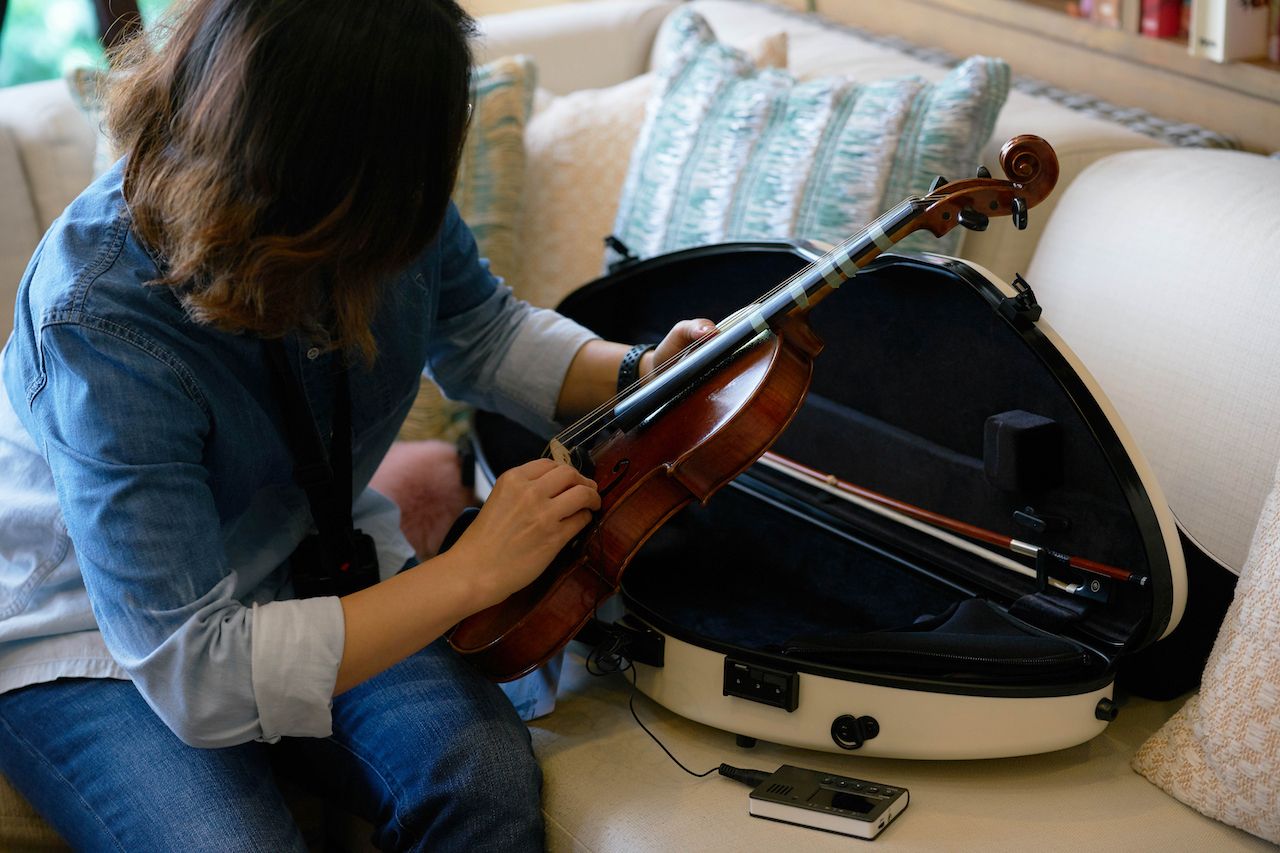
Photo: Vach Cameraman /Shutterstock
- Get a good case: No matter where you’re going and how you’re getting there, you need to get your instrument a good case. Hard-shell cases can be very expensive, but if you value your instrument, it’s a must-have. Many also have a locking system with a combination code, which adds an extra layer of safety. Note that airlines usually require travelers to place instruments in hard-shell cases.
- Before flying: If you have any doubts, call the airline when booking your trip. Make sure you have read all the requirements and have the dimensions of your instrument ready. You should get all the info you need from them before your trip so there’s no surprise upon boarding.
- Boarding an airplane with an instrument: Most airlines recommend those who travel with an instrument as a carry-on to board first. Go to the agent at the gate and explain that you are bringing your instrument as a carry-on and want to board early to place it safely in an overhead compartment. This way, you’ll be sure to have the safe space you need for your instrument. If you board later and there’s no room in the overhead compartment for your instrument, you may need to check it.
- In the airplane: If you don’t have a choice but to buy an airplane seat for your instrument, you’ll need to secure it in its case with the seatbelt (and possibly other straps if the instrument is large, like a cello) and make sure it doesn’t obstruct exits or signage. A properly secured case is not only good for the instrument, but for all the people in the airplane who have no desire to get hit by a loose hard-shell case during take-off or turbulence. It’s also worth remembering that most airlines require your instrument to be on the seat directly beside you, and you can’t book an emergency row seat if you have your instrument as a cabin-seat baggage.
What you can do if you can’t fly with your instrument
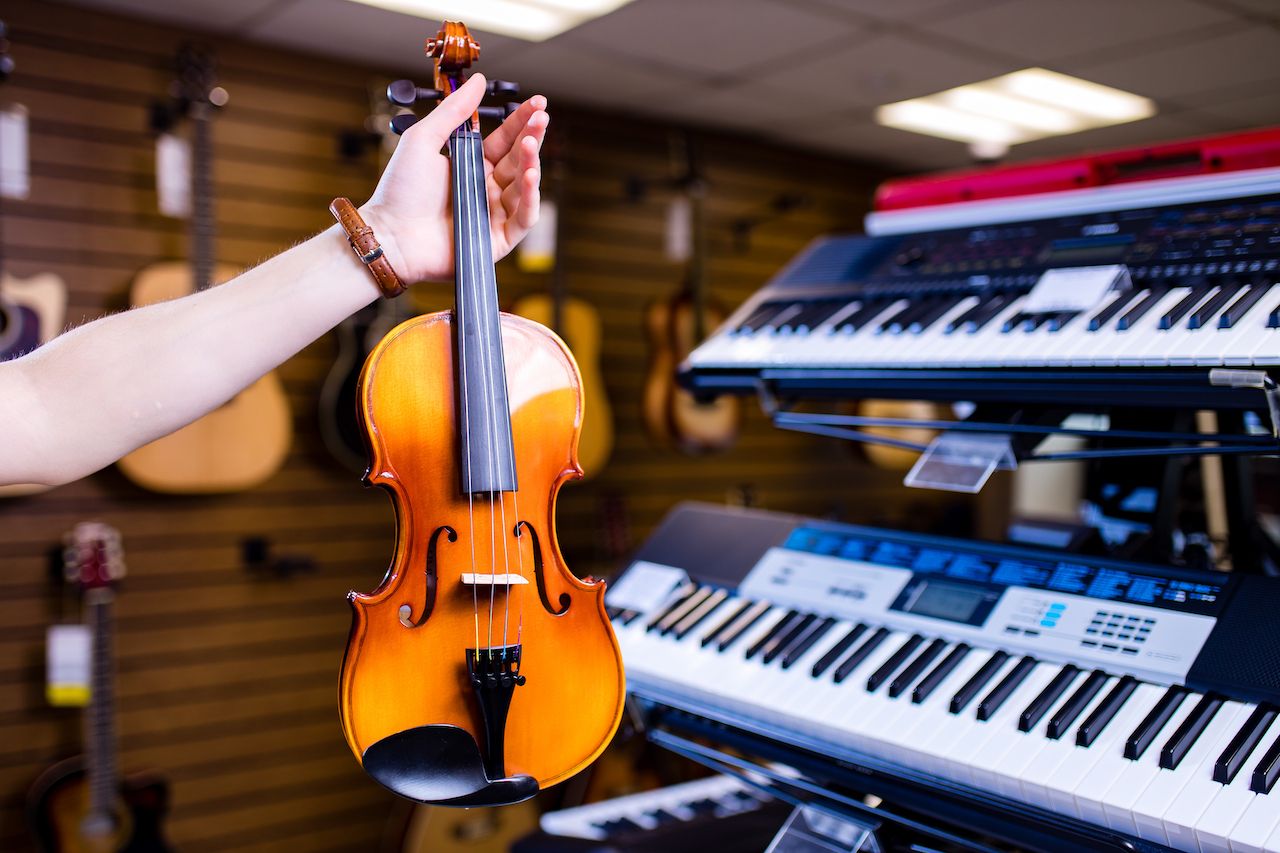
Photo: Yurakrasil /Shutterstock
If, like me, you’re giving up on bringing your instrument with you, there’s a simple alternative that can turn out to be great fun.
Upon arriving at my destination, I called the music shops in my area and asked if I could rent a student violin from them. While no shop carried violins, one of them gave me the number of a local luthier who would be able to help. I called and got an appointment almost right away. For less than $20 for four weeks, and a damage deposit of about $1200, I was able to rent a beautiful 1940s instrument.
I had never played a violin other than my own and the change was fun and quite eye-opening. Like my violin teacher says: “It’s like having a new voice.”
While this solution is not perfect, especially for professional or advanced musicians who need to travel with their own instruments, it’s a cheap and fun solution for amateur musicians who still want to practice on vacation.
Above all else, read the fine print

Photo: Erickson Stock /Shutterstock
What I did the night before my trip, I should have done as soon as I booked my flight. That way, I would have been less rushed and able to read all that Air Canada had to say about traveling with an instrument.
Yes, my violin was much bigger than the carry-on size requirements, but at the very bottom of the page on Air Canada’s webpage about traveling with an instrument is a very small section that reads: “Exception: String instruments (e.g. guitars, violins and violas) can be carried on board – even if their dimensions slightly exceed Air Canada’s carry-on size requirements – as long as they fit in the overhead bin and there is space available in the cabin at time of boarding.”
More like this
Trending now, the 25 dreamiest airbnbs in italy, 21 zion national park cabins to make your desert dreams come true, this road trip expert’s free map of 429 national park sites will vastly improve your us travels, the 20 best airbnbs near universal studios orlando, the 9 best travel rewards credit cards for 2024, discover matador, adventure travel, train travel, national parks, beaches and islands, ski and snow.
Free shipping on all orders over $45 shipped in the US. - Learn more
Love it or return it – 30-day Guarantee. - Learn More

- Beginning Violins
- Intermediate Violins
- Advanced Violins
- Professional Violins
- Electric Violins
- Clearance Violins
- Beginning Violas
- Intermediate Violas
- Advanced Violas
- Professional Violas
- Electric Violas
- Clearance Violas
- Beginning Cellos
- Intermediate Cellos
- Advanced Cellos
- Professional Cellos
- Clearance Cellos
- Beginning Basses
- Intermediate Basses
- Advanced Basses
- Electric Basses
- Clearance Basses
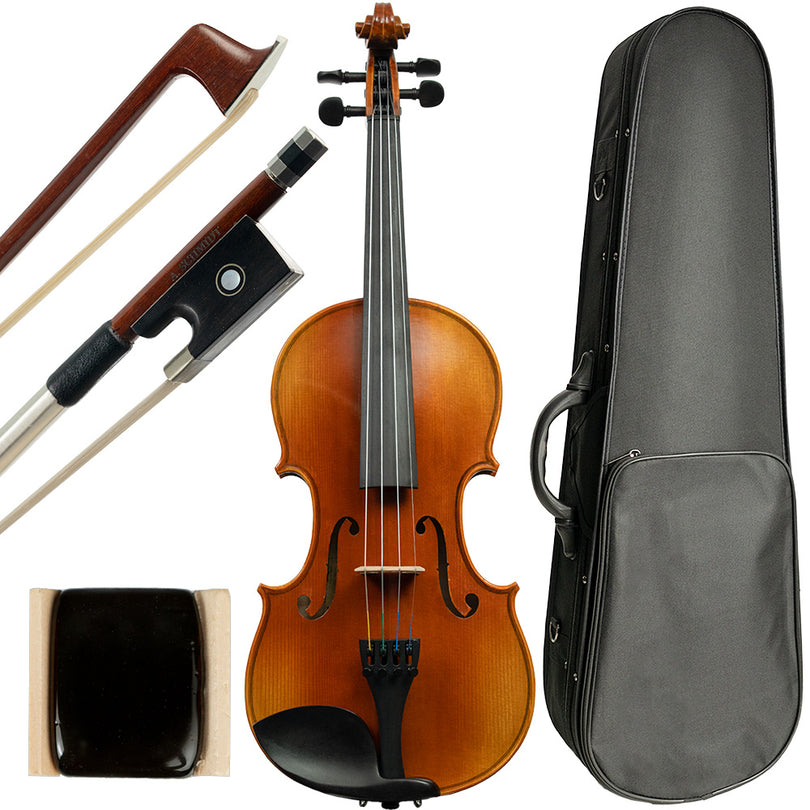
Franz Hoffmann Concert Violin
- Beginner Violin Bows
- Professional Violin Bows
- Wood Violin Bows
- Carbon Fiber Violin Bows
- Beginner Viola Bows
- Professional Viola Bows
- Wood Viola Bows
- Carbon Fiber Viola Bows
- Beginner Cello Bows
- Professional Cello Bows
- Wood Cello Bows
- Carbon Fiber Cello Bows
- Beginner Bass Bows
- Wood Bass Bows
- Carbon Fiber Bass Bows
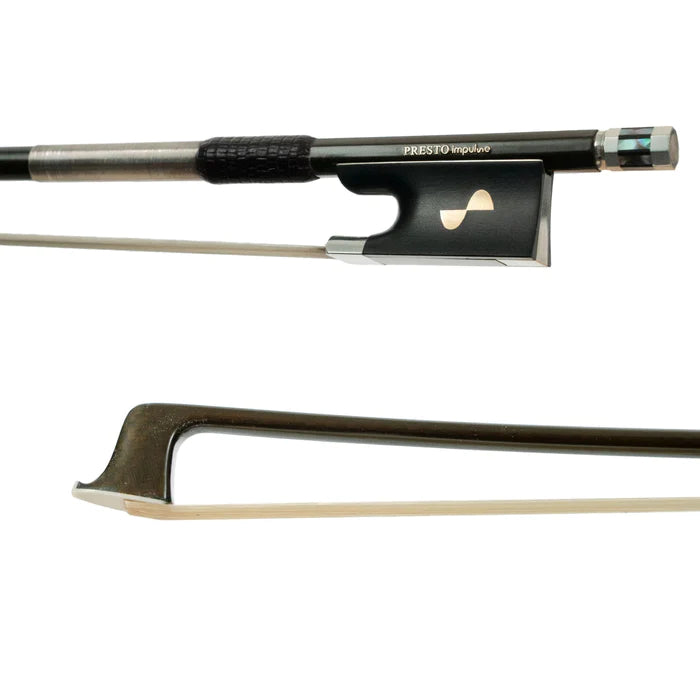
PRESTO impulse Violin Bow
- Student Violin Cases
- Traditional Violin Cases
- Carbon Fiber Violin Cases
- Student Viola Cases
- Traditional Viola Cases
- Carbon Fiber Viola Cases
- Hardshell Cello Cases
- Soft Cover Cello Cases
- Padded Cello Bags
- Soft Cover Bass Cases
- Padded Bass Bags
- Double Cases
- Case Covers
- Straps & Case Accessories
- American Case Company
- Heritage Cases
- Super Light Cases
- Toshira Cases
- Musafia Cases
- Jakob Winter Cases
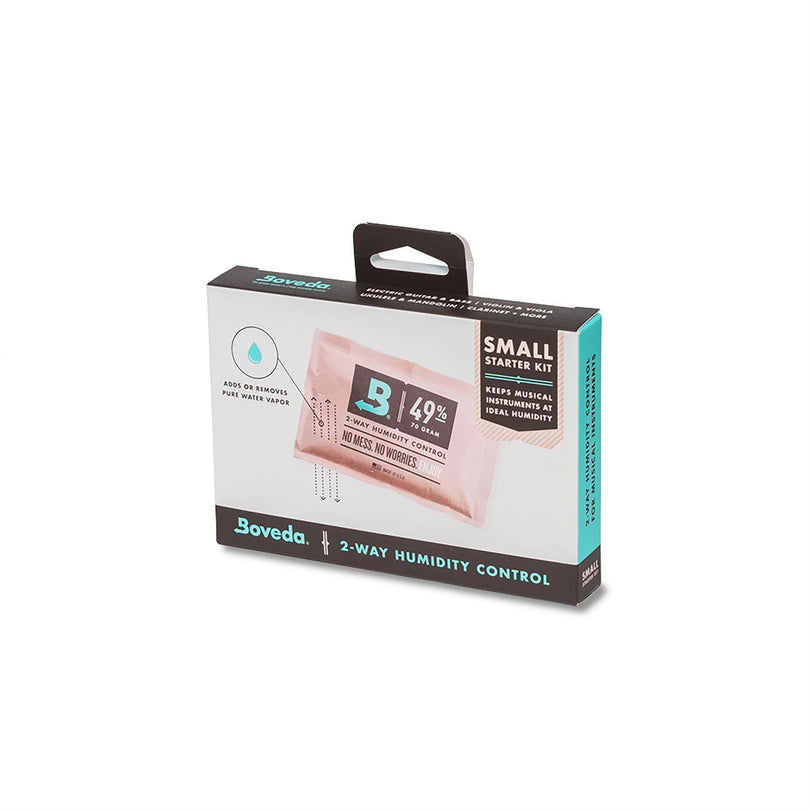
Boveda Humidification System
- Violin String Sets
- Individual Violin Strings
- All Violin Strings
- Viola String Sets
- Individual Viola Strings
- All Viola Strings
- Cello String Sets
- Individual Cello Strings
- All Cello Strings
- Bass String Sets
- Individual Bass Strings
- All Bass Strings
- Guitar Strings
- da Gamba Strings
- Electric Strings
- Mandolin Strings
- Evah Pirazzi

"I have never played such powerful strings before." - Dami Kim
- Violin Sheet Music
- Digital Violin Music
- Viola Sheet Music
- Digital Viola Music
- Cello Sheet Music
- Digital Cello Music
- Bass Sheet Music
- Digital Bass Music
- String Duets
- String Trios
- Piano Trios
- String Quartets
- Quintets & More
- Digital Ensemble Music
- Suzuki Method
- Mark O'Connor Method
- Evelyn Avsharian Series
- Essential Elements
- All for Strings
- All Methods & Series

Wee Violin: World Music Preparatory to Twinkle
- Shoulder Rests
- Violin & Viola Rosin
- Violin & Viola Mutes
- Violin & Viola Humidifiers
- Violin & Viola Stands
- E-Loop Protector
- Shoulder Rest Parts
- All Violin & Viola Accessories
- Cello & Bass Rosin
- Cello & Bass Mutes
- Endpin Anchors & Stops
- Cello & Bass Humidifiers
- Chairs & Stools
- Cello & Bass Stands
- Wolf Eliminators
- All Cello & Bass Accessories
- Teaching Aids
- Music Stands & Accessories
- Cleaner, Polish, Cloths, & Care
- Metronomes & Tuners
- Humidifiers
- Amplification
- Instrument Stands
- Books, DVDs, & Media
- Bow Accessories
- Case Accessories
- All String Accessories
- String Adjusters
- All Luthier Supplies
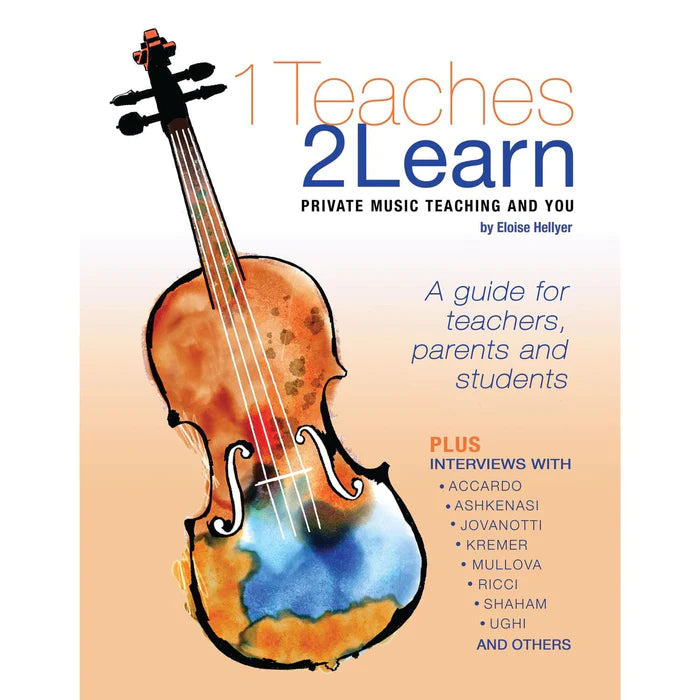
1 Teaches 2 Learn: Private Music Teaching and You by Eloise Hellyer
- Michigan Rentals
- Repair & Restoration
- In-Home Trials
- Other String Instruments
- Violin Bows
- Violin Cases
- Viola Cases
- Cello Cases
- Other Cases & Accessories
- Cases by Brand
- Violin Strings
- Viola Strings
- Cello Strings
- Bass Strings
- Other Strings
- Strings by Brand
- Violin Music
- Viola Music
- Cello Music
- Ensemble Music
- Methods & Series
- Violin & Viola Accessories
- Cello & Bass Accessories
- Luthier Supplies
Your cart is empty
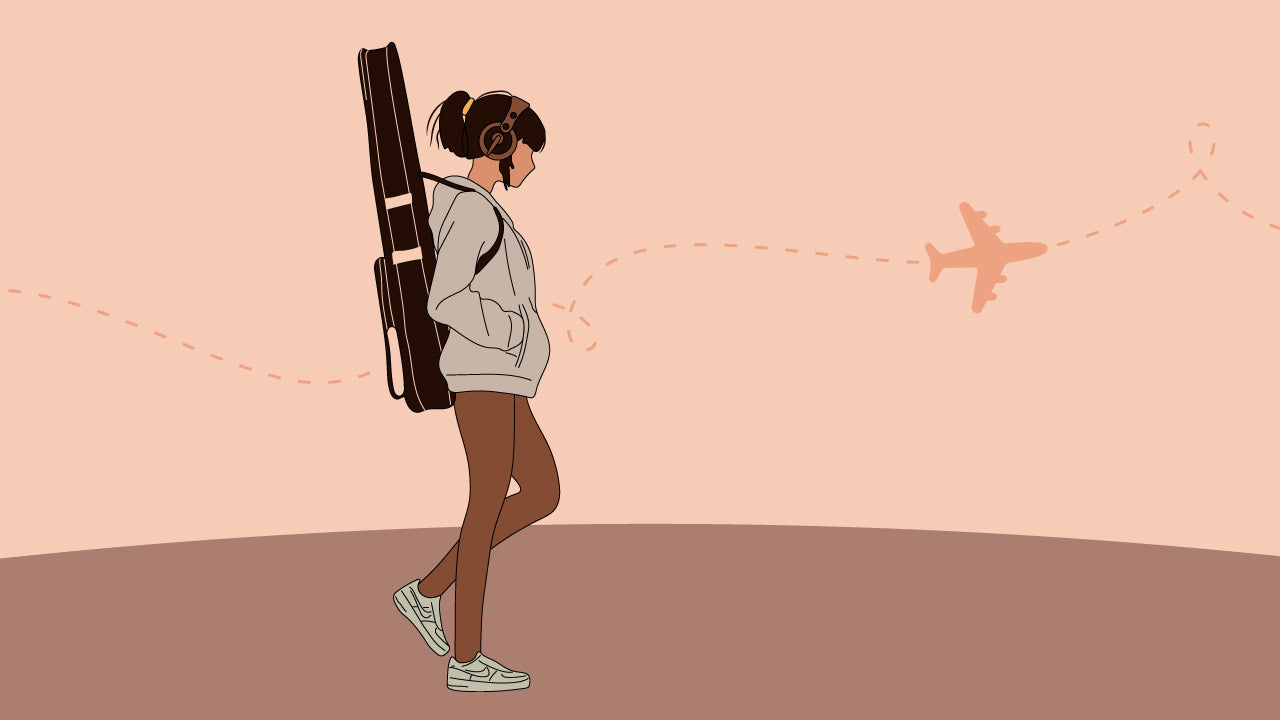
Airplane Advice: a guide to traveling with your instrument
- Educational Corner
Traveling by air can be overwhelming, and even more so if you’re planning to take your instrument with you! We wanted to give you a few tips on how best to prepare your instrument (and yourself) for some common in-flight issues you might come across on your next adventure.
Before you fly, make sure that you are using a hard case to store your instrument. Soft cases will not be durable enough to withstand the stress of jostling luggage and a pressurized aircraft cabin, so opt for a hard case that’s made of hard thermoplastic, wood, hardened foam, or carbon fiber to protect your instrument. Another case-related tip is to make sure your case is labelled with a luggage or instrument tag . Hopefully you never get separated from your instrument, but in the unlikely event that it happens, a tag with your information can be very handy to have on your case.
Looking inside the case, there are a few things that can be helpful to cross off your list before flying. Firstly, empty the compartments of any sharp objects. Some of us like to carry things like nail clippers or other sharp tools in our cases, but a discerning TSA agent is likely to confiscate those items, so it’s best to just get ahead of it. This is also a good opportunity to check your humidification setup. Planes are notoriously low in humidity, which can contribute to the wood of your instrument contracting and ultimately, splitting or creating an open seam. An easy way to prevent that is to make sure your humidification set up is optimized so that your precious instrument does not have to experience a huge change in the humidity levels during or after the flight.
Moving on to the actual instrument, there are only a few things left to do before getting to the airport, and they mostly revolve around trying to release tension on the instrument. Planes tend to be highly pressurized, so we try to take some pressure off the instrument by loosening the pegs slightly (about a whole step or so) to ease tension on the bridge. In addition, make sure your bow is also loosened to ease any tension on the stick of the bow. The last step is to wrap your instrument in a cloth or instrument bag. This will help maintain and regulate the temperature, especially when it’s up high in those cold overhead bins.
Now onto travel day! When you get to the airport, going through security is one of the first steps. Keep your instrument and bow inside the case when going through the X ray machine. This will ensure that it stays protected and doesn’t get jostled around by other luggage that is passing through the belt. Sometimes, a security agent might want to do a physical inspection of the case, and that is completely fine. They might just need some reminders on how to handle a delicate instrument!
After passing through security, you’re in the home stretch! When you get to the gate, ask the agent if they might allow you to board a bit early so that you can put your instrument safely in the overhead bin. When you get onboard, find an overhead compartment that is near your seat so that you can keep your attention on it. Sometimes, people don’t know that there is an instrument in the bin they’re aiming for, and it’s helpful to let them know before they attempt to jam their luggage wheels-first into your treasured instrument!
After the flight is finished boarding and you fasten your seatbelt, your part is done. You can rest assured that you’ve done everything you can to ensure your instrument’s safety, and it should arrive safe and sound to your destination. Just tune it back up to pitch, tighten your bow, and you are all set to perform at your new destination. If you have any other tips and tricks that you use when traveling, be sure to put it in the comments to share. Safe travels and happy practicing!
Note: these tips mostly apply to violins or violas since cellos and basses will most likely be under the cabin as checked luggage or in the seat next to you if you choose to buy a seat for your cello.
Continue reading

Listen, if You Dare: Our Favorite Horror Movie Themes to Practice this Season
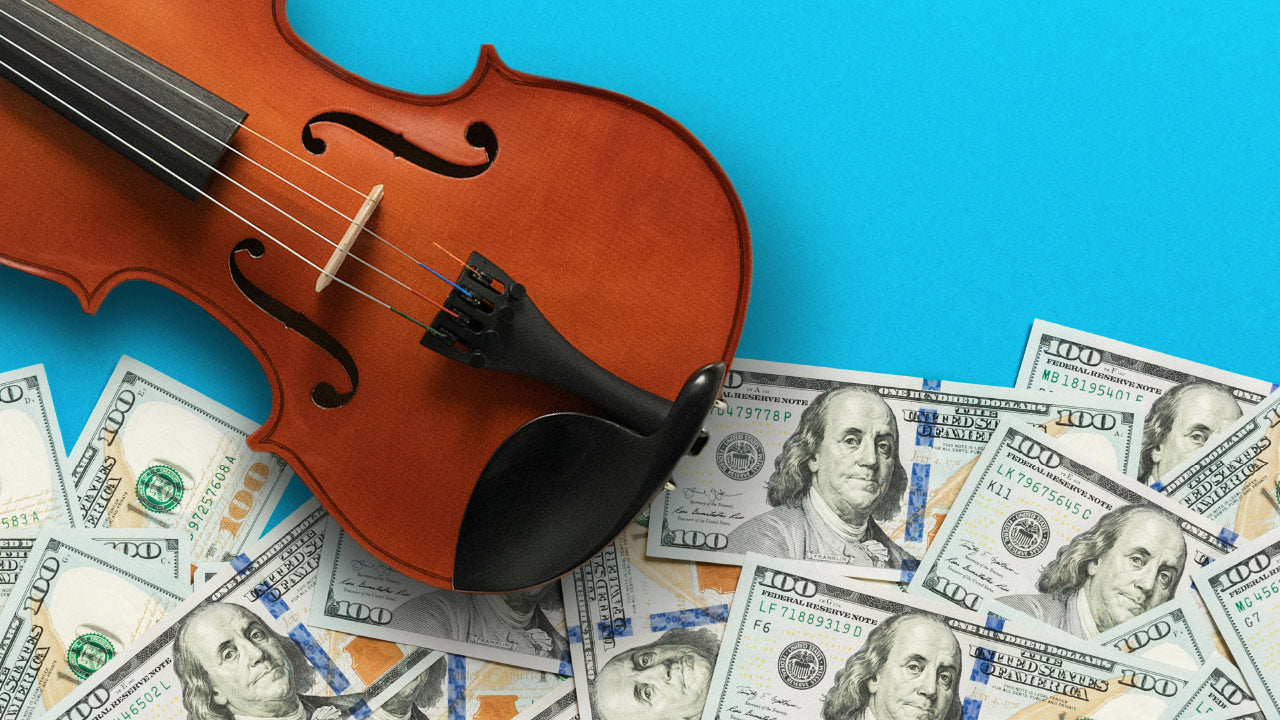
Why Choose the More Expensive Violin?
Leave a comment
All comments are moderated before being published.
This site is protected by reCAPTCHA and the Google Privacy Policy and Terms of Service apply.
30-DAY GUARANTEE
EXPERT HELP
FAST DELIVERY
QUALITY COMMITMENT
Everything you need to know about flying with your guitar
Taking your precious guitar on a plane, or out on the road, can be a daunting prospect. We're here to help you navigate...

For any musician, the chance to take your art out on the road and connect with fans from far afield is an exciting one. But what if said fans are in a different country, or if taking to the skies to travel is unavoidable? The prospect of packaging up your precious guitar and entrusting airline baggage handling professionals to safely get it from A to B could be enough to put you off, but it needn’t.
In this article, we will explain some things to consider when traveling with your guitar. From best practices and steps you can take before you travel to ensure your guitar has the best chance of arriving at your destination in one piece, we’re here to help.
Do your research before you travel
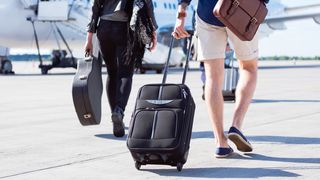
Before you get all excited and start booking your flight tickets, take a minute to plan out how your guitar will complete its own airline odyssey safely. Unfortunately, it’s not as simple as throwing it in a gigbag and rocking up to the boarding gate.
Different airlines – and even different countries – have varying rules and restrictions regarding traveling with musical instruments. Some may allow you to carry your guitar on as cabin baggage, while others may require it to be checked in. Research the airline and country-specific guidelines to avoid unpleasant surprises at the airport.
You’re also going to want the best possible case your budget will allow. Seriously, this isn’t the area to skimp. Protect your guitar like a precious gem by investing in a sturdy, well-padded travel case. We’ll outline some other case-related things to think about later on in this guide.
Once you’ve got a case, and before you board the plane, remember to loosen the guitar strings slightly to relieve tension caused by changes in air pressure. This simple step can help prevent damage to the neck and ensure you don’t return to find cracks in the wood.
It’s also worth padding out the inside of the case further if you can; T-shirts, towels, whatever you can find that will keep the instrument rock-solid in its safest position. Another handy tip is to locate some of those desiccant sachets you find when you buy new electronic products. These will help protect the guitar from changes to humidity, so keep hold of them when you come across them in future!
Get The Pick Newsletter
All the latest guitar news, interviews, lessons, reviews, deals and more, direct to your inbox!
Navigating airport procedures

As you embark on your musical adventure, airport procedures can be a potential hurdle. You can give yourself a calmer experience by simply arriving earlier at the airport, especially if you plan to carry your guitar on as cabin luggage. Early arrival allows for a stress-free check-in process and helps you avoid rushing through security.
When traveling with your guitar as cabin baggage, declare it at the security checkpoint. Alternatively, if cabin space is limited, some airlines offer gate-check services for musical instruments. Request this option to reduce the risk of mishandling during the flight.
Finally, while it might seem optimistic, affixing a few visible ‘fragile’ stickers to your guitar case will give it a fighting chance of being treated kindly by airline baggage handlers. Doesn’t hurt to try, right?
Legalities and documentation

Ensuring you have the right paperwork is crucial to avoid legal hassles when traveling internationally with your guitar. Thankfully, while there is paperwork to consider, it’s fairly straightforward to understand.
First, we’d advise reading up on your domestic government’s website to see about any restrictions or red tape you’ll need to consider. For example, in the UK, where Britain’s exit from the European Union created a world of new bureaucracy, you’ll find Government-approved information relating to musicians’ travel on its website. Essentially, in the UK, you can apply for a Musical Instrument Certificate, which lasts for three years and can be used multiple times within that period. You’ll also find the UK’s Musicians’ Union offers up-to-date information to support traveling musicians and give them the best chance of arriving at their destination with their instruments intact.
Another thing you’ll need to consider, and one that will require you to have a full understanding of the tonewoods in your guitar, is CITES documentation. Essentially, for guitars comprising protected wood species, like Ebony or Rosewood, you’ll need the required CITES (Convention on International Trade in Endangered Species of Wild Fauna and Flora) documentation to comply with international trade regulations. It’s a small detail but, if not accounted for, one that could quite conceivably cause you, at best, delays at the other end; or worse, see your guitar being confiscated.
Insurance and repairs

If you haven’t already got an insurance policy, we’d say international travel would be a good reason to change that. Your existing home insurance may cover the guitar within its country of origin but that might not extend to international travel.
Thankfully, there are some trusted, reputable companies offering dedicated musician’s insurance, like Allianz, offering financial protection and peace of mind in case of loss, theft, or damage.
Additionally, if you are super organized, you might consider researching reputable instrument repair shops at your destination in case any unforeseen mishaps occur during your trip. Can’t be too careful.
Guitar cases

When you’re looking for the best guitar case for air travel, you have a decision to make. Are you looking to take your guitar with you, never letting it out of your sight? If so, you’ll be better served with a rigid, but not hard-shell, gigbag. This is because you’ll likely need to store the guitar in the overhead lockers, a feat made slightly simpler when the case in question isn’t hard.
If, on the other hand, you’re happy to entrust your guitar to the baggage handlers, and leave it in the hold, then go for as robust and rigid as you can. Additionally, you’ll want to ensure it has reliable locks and the all-important fragile stickers we mentioned earlier.
While you could look for value if you’re going down the gigbag route, we’d still recommend sticking with a trusted brand like Gator or SKB. For hard cases, you’ll often find the best cases are the ones from brands like Fender and Gibson themselves. These will cost you a fair amount, but you can at least rest easy knowing your guitar is safe.
Bon voyage!
Congratulations! You're ready to embark on your international musical adventure with your guitar. Armed with this guide, you can confidently navigate airport procedures, protect your instrument, and avoid potential problems along the way. For all the horror stories you’ve probably heard, traveling with your guitar doesn’t have to be a nightmare if you stick to our tips, plan ahead accordingly and give yourself plenty of time to tick all the relevant boxes.
- Best travel guitars : acoustics and electrics for portability and performance
Thank you for reading 5 articles this month**
Join now for unlimited access
US pricing $3.99 per month or $39.00 per year
UK pricing £2.99 per month or £29.00 per year
Europe pricing €3.49 per month or €34.00 per year
*Read 5 free articles per month without a subscription
Prices from £2.99/$3.99/€3.49

Chris Corfield is a journalist with over 12 years of experience writing for some of the music world's biggest brands including Orange Amplification, MusicRadar, Guitar World, Total Guitar and Dawsons Music. Chris loves getting nerdy about everything from guitar gear and synths, to microphones and music production hardware.
How to sound like IV from Sleep Token: Rig secrets revealed, from guitars and effects, to tones and tuning
“It was very emotional. He said, ‘This is where it belongs’”: Jon Bon Jovi has been reunited with the first guitar he ever owned, 45 years after he sold it
“One of the most successful instrumentalists in rock history”: Duane Eddy, rock guitar pioneer, dies at 86
Most Popular
- Travel Gear • Packing Tips
- Travel Gear
- Packing Tips
Packing Tips for Traveling with Musical Instruments
Published September 7, 2021
Written by:

Jessie Beck
Jessie is a writer, editor, and content marketer who covers travel gear and adventure travel. She’s called many places home...

Jenn Sutherland-Miller
Jenn raised 4 children while traveling full-time for more than a decade– it’s called worldschooling and it’s awesome. Jenn has...

The Tortuga Promise
At Tortuga, our mission is to make travel easier. Our advice and recommendations are based on years of travel experience. We only recommend products that we use on our own travels.
Table of Contents
Traveling with a musical instrument can be a pain — especially if you play something larger than a flute. I speak from experience. I’ve traveled with my guitar more than a few times, and later — being too cumbersome to travel with — swapped out the guitar for a ukulele I “borrowed” from my little brother for awhile.
Hassles aside, though, my guitar was responsible for my first study abroad friend (Hi, Matze!) and — since I carried the ukulele around without a case — I was frequently approached by excited Ticos in Costa Rica who’d exclaim, “Guitarrita!” and smile when I played a few quick chords.
Traveling with an instrument can be a ton of fun and a wonderful icebreaker, so don’t let the complicated logistics stop you. Here’s the low-down on how to flying with musical instruments as well as tips for how to pack musical instruments for travel.
Do Musical Instruments Count as a Carry On ?
Yes. Recently, the U.S. Department of Transportation passed a rule requiring airline carriers to allow small musical instruments on board aircraft as a carry on just like any other piece of luggage . So, if your musical instrument is small enough to fit in an overhead compartment–violins, violas, and (usually) guitars–then yes, you can bring it as your carry on .
Like any other piece of luggage, you’ll be able to store it on a first come first served basis and could be requested by flight attendants to check it at the gate. This is a good reason to purchase a pre-boarding service.
However, having flown with a guitar on several occasions, I’ve found that not all aircraft have compartments big enough for it. Usually, an international flight is fine but some shorter flights with small “commuter” aircraft tend to pose a problem. In this circumstance, it’s kind of hit or miss. I’ve been on flights where they were empty enough to give my guitar it’s own seat (free of charge), whereas others have required me to check it at the gate.
As for dealing with TSA, be courteous and ask that they handle your instrument with care if they need to check out the bag.
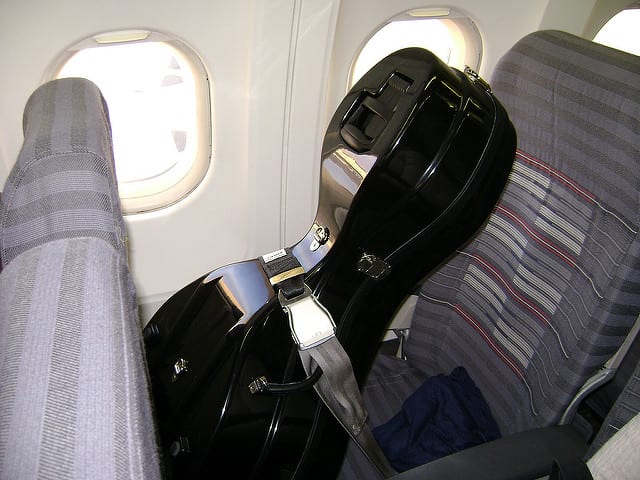
Buying a Seat for Your Instrument
Those who play larger instruments, like a cello or a harp, have the option of buying a seat for an instrument.
Amateur musician, Cristina Wallace says in a recent CNN article about flying with instruments , “My cello has his own frequent flier account.”
This is a more expensive route but worth it if you have a valuable instrument that you don’t want to risk checking. If you go this route, though, just make sure that you:
- Notify the airline(s) you’re flying with 24 hours in advance of departure
- Like you would with any large equipment, try to arrive at the airport at least 30 minutes earlier than usual and be prepared to potentially run into problems .
- Choose your airline carefully. According to cellist Gregory Beaver, Delta tends to treat musicians traveling with large instruments better than United .

Checking Your Instrument
Sometimes, there’s just no way around checking your instrument. Whether the overhead compartment space is full or you aren’t able to buy a seat for it, here are a few tips to help you when checking your instrument as luggage :

Consider Buying a “Beater” Instrument
I have two guitars: the $100 Yamaha I learned to play on, and the $1,000 Esteve I bought when I became more serious. If I ever want to travel with a guitar, you’d better believe I’m packing the Yamaha
Although I still take precautions to make sure my guitar is safe when checked (and try to carry it on as often as possible), I’d still rather rest assured that if something happens to it (e.g. lost, broken, stolen) it’ll be easy and relatively cheap to replace. Also, I’ve never found a backpack guitar I really liked (hence the ukulele).
Get Travel Insurance
The airlines aren’t liable for your instrument — even if it’s their employees carelessly flinging it around (there’s even a song about United’s terrible reputation with breaking guitars ) As such, you should really get travel insurance to cover you in the case that something happens to your instrument. Just be sure to read the fine print and make sure instruments are covered on their policy (most will).
Check Guitars and Smaller Instruments at the Gate
Since you’re legally allowed to bring it on the plane with you, wait until you’re at the gate to check it. It’ll have a better chance of making it on the plane and not getting lost in transit.
How to Pack Musical Instruments
Regardless of whether you’re checking your instrument, bringing it on an airplane, or taking it with you on a road trip, here are some tips for packing your instrument for travel:
- Get a hard case . For guitars, this case is a great option.
- For wooden instruments, put a humidifier in your case to avoid cracking.
- Detune the strings on a string instrument — especially for air travel — to keep them from snapping.
- Make sure you pack all loose space with socks, clothes, or other soft objects. I’ve even heard of piccolo and flute players packing their instrument in their suitcases and having no issues.

Cellist, Zoe Keating, for example says, to always, “Use a BAM flight cover over the case, detune the top and bottom string and pack socks all around the cello,” like she does to prep her cello for travel.
Whether you just want to bring your instrument on your next vacation, or you’re flying across the country for an amateur performance, traveling with an (expensive and fragile!) instrument isn’t always easy. To help make things easier:
- Smaller instruments count as carry on luggage . Consider paying for priority boarding to get first dibs on overhead compartment space.
- Notify the airlines at least 24 hours in advance and allow yourself extra time at check-in if you’ve bought a seat for your instrument.
- If you’re checking your instrument, pack it well in a hard case, get travel insurance, or consider buying a cheap travel version of your instrument.
Related Articles

The Best Travel Gear for Your Next Big Trip

The Best Travel-Sized Toiletries to Pack for Your Trip
Tortuga travel backpack pro $350.
Max Carry On Size
Jessie is a writer, editor, and content marketer who covers travel gear and adventure travel. She’s called many places home and traveled to 45+ countries.
She now lives in San Francisco with her husband where she splits her time between traveling, adventuring outdoors, and cooking (okay, eating).
Read more from Jessie
Find the perfect pack for your next trip
Take Our Bag Finder Quiz To Find The Perfect Bag For Your Next Trip
Bring everything you need without checking a bag.

Which airlines are best for musicians travelling with instruments?
The International Federation of Musicians has identified the airlines that give you the most favourable treatment if you are travelling with your instrument.

The FIM ranks airlines green if they permit instruments to be carried in the cabin when they fit in the overhead locker or under the seat in front of the passenger regardless of size, which is the USFAA regulation. Reflecting the repeated problems musicians have encountered in recent times, only 11 airlines make the grade, including Air Canada, American Airlines, Air Brussels and Southwest Airlines.
Airlines that do not comply with USFAA regulations but which have larger size limitations for instruments compared to normal baggage are rated orange, while those applying the same size to instruments and cabin baggage get a thumbs down with a red mark.
By far the majority of airlines surveyed, a total of 79, are ranked red, with 29 getting orange status. Some of the best known in the red category are Air France, Air Berlin, Lufthansa, Ryanair and Virgin Atlantic.
The IFM cautions that its list offers no guarantee that the best-ranked airlines will accept an instrument. They point out that instruments are only accepted if there is enough room in the cabin and that musicians are advised to get to the gate early.
Find out more here .
Leave a Comment

6 Tips for Flying With Instruments

Laws governing travel with a musical instrument vary from country to country, but many places now have rules on the books that dictate how airlines must accommodate musicians traveling with precious cargo. In the United States, the Department of Transportation implemented the FAA Modernization and Reform Act of 2012, which mandates air carriers allow passengers to bring small instruments such as a guitar or violin as carry-on luggage, provided those instruments can be properly stored per FAA safety regulations.
Of course, there are exceptions to every rule and variations from carrier to carrier. With that in mind, here are a few handy tips to ensure you’re priceless viola or bouzouki gets from point A to point B in one piece: 1. Prepare for Lift Off
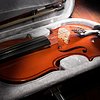
If you’re flying, loosen the strings on your instrument to accommodate temperature changes. Remove any potentially dangerous accessories like weighty metal capos, and if you’re checking your instrument, write a clear and concise note to security detailing how your instrument should be repacked for safe travel. Lastly, put a big, bold fragile sticker on your case. Better yet, add a couple stickers, and put them in very conspicuous spots.
2. Get Familiar with Your Airline’s Luggage Policy
Even when the law is in your favor, airline staff may not be familiar with regulations and boarding is not an ideal time to run into trip-altering hurdles. Read up on each airline’s policy before booking your ticket, and, whenever possible, get confirmation in writing that you’re allowed to fly with your instrument. Bring that letter with you to the airport just in case you encounter resistance.
3. Leave Room in Your Schedule for Security Checks

Instruments are often subject to extra scrutiny. After your instrument is x-rayed, security agents may also conduct a physical inspection and explosives trace detection test, and all of that takes time.
4. Board Early
Since overhead compartment space is generally available on a first come, first served basis, it’s worth paying extra to board early and ensure your instrument gets a spot. If early boarding isn’t an option or if you’re flying on a small commuter-style aircraft, ask about gate-checking your instrument instead. For larger instruments like a harp, consider buying a second seat.
5. Invest in a Travel Friendly Case
Instruments fare best in hard-shell cases with expertly designed suspension, especially if you plan on checking your instrument. Many brands offer extra features that help out when you’re on foot at a festival or running for a taxi as well as hopping on a flight. In addition to packing a high-density foam interior and air-tight accessory space, the Bam France Trekking Violin Case comes with a pull-out waterproof nylon cover and backpack straps. Style Acoustic Guitar makes its line of cases using ATA-molded, military-grade polyethylene and TSA-approved locking latches.

6. Have an Insurance Policy in Place
Airlines are careful to limit their liability. Protect yourself with a third-party insurance policy so that if something does go wrong, you’ll have funds for repair or replacement.

Whether you’re headed to the next date on your tour or just taking your ukulele home for a casual performance at a family reunion, making beautiful music requires an instrument that arrives in tip-top shape. With just a little preparation and research, you can safeguard your next sonata—and perhaps even your career.
Explore More About
- Travel Gear
- Trending News
Love travel?
More from guru tips.

- Want more Guru tips? Sign up for our free newsletter. Sign up Please enter a valid email
SeatGuru.com is a participant in the Amazon Services LLC Associates Program, an affiliate advertising program designed to provide a means for sites to earn fees by linking to Amazon.com and affiliated sites.
SeatGuru was created to help travelers choose the best seats and in-flight amenities.
- NEW COLOURS
- Classic Tech
- Classic Plus
- Classic Pro
- Classic Flight
- Military Backpack
- Underseat Bags
- Laptop Backpacks
- Gym and Work Backpacks
- Minimalist Backpack
- > Show All
- Classic Cross Body Bags
- Packing Cubes
- British Airways
- Backpack Size Guide
- > More Backpack Guides
- Carry On Luggage Size Guide
- > More Cabin Bag Guides
- Travel Gift Guide
- Digital Nomads Hub
- Travel News
- Destinations
- Product & Style
- Travel Light
- Packing Tips
- Packing Lists
- Air Travel Tips by Airlines
- Luggage Tips
- Pre-flight Checklist
- In-flight Checklist
- Layover Tips
- CABIN MILES
- Backpacks CLASSIC NEW COLOURS Classic Classic Tech Classic Plus Classic Pro Classic Flight ADVENTURE NEW COLOURS ADV ADV Pro ADV Dry MILITARY Military Backpack SIZE 28L 30L 32L 36L 42L 44L SHOP BY FUNCTION Cabin Bags Underseat Bags Laptop Backpacks Daypacks Gym and Work Backpacks Minimalist Backpack
- Shoulder Bags > Show All SHOULDER BAGS Sidekick Flipside Flapjack Classic Cross Body Bags
- Bum Bags > Show All BUM BAGS Hustle Hip Bags
- Accessories > Show All ACCESSORIES Rain Cover Packing Cubes Gift Cards
- Blogs Product Guides Backpack Size Guide > More Backpack Guides Carry On Luggage Size Guide > More Cabin Bag Guides Travel Gift Guide Our Journey Digital Nomads Hub Travel News Destinations Product & Style Cabinzero Travel Tips Travel Light Packing Tips Packing Lists Day Trips Air Travel Tips Air Travel Tips by Airlines Luggage Tips Pre-flight Checklist In-flight Checklist Layover Tips
Guide To Flying With Musical Instruments: Complete Instructions
Travelling with your musical instruments can be tricky, but with good preparations, you can always have peace of mind. Speaking of which, our complete guide to flying with musical instruments will provide important insights to ensure your instruments arrive safely. Use the instructions to enjoy flying most comfortably with your cellos or guitars.
Rules On Travelling With Musical Instruments

Everything you need to know when flying with an instrument. Photo by Mirko Vitali - stock.adobe.com
According to the Transportation Rules for Musical Instruments from the US Department of Transportation, it’s required by law that passengers can bring musical instruments to the plane as carry-on or checked baggage . However, there will be regulations on their weight and size limits , which will vary depending on the airlines.
More Ground Rules
The TSA states that all musical instruments (and sporting equipment) must be inspected at the security checkpoint when transported as carry-on . As checked baggage, they also have to pass through the screening.
Most of the time, you must purchase another seat for your large instruments. Ensure the instruments can be safely stored on your extra seat and don’t exceed their weight or size limits.
Plus, you can bring multiple instruments as your carry-on or checked baggage. Just ensure they comply with the weight and size limits of the airlines (fit inside the overhead bin or under the front seat). And usually, it’s recommended that you arrive early to allow for extra check-in time.
At the same time, large instruments can be checked in the hold when you board the flight. But if you are concerned about their handling, you can carry them onto the plane if there is room available. Most people would agree that it’s better to carry your beloved instruments yourself than to check them in.
If you fly your musical instruments as checked baggage, ensure they’re well protected from mishandling. Most of the time, the airlines aren’t liable for any damages to the items during transportation. So, make sure always to have your safety measurements.
That said, there’s even a limit to how large or heavy an instrument the plane’s cargo can carry. If your instruments exceed the maximum checked baggage weight or dimensions, you may have to ship them as cargo (i.e. transported on a separate plane or flight).

A small Ukulele can be easily accepted as a carry-on. Photo by kikearnaiz - stock.adobe.com
Musicians-Friendly Airlines
Almost all airlines accept your instruments of choice. However, some provide a better experience than others. In general, most recommend flying with Southwest, United and American if you want to have a decent time. Here’s a cheat sheet for their rules regarding your violin, guitar, drums and all that jazz:
Other airlines you should keep an eye on:
- Alaska Airlines
- Delta Airlines
Facts You Need To Know
In the past, it was common to use ivory to make the instruments, such as piano keys, piano bows, and more. However, it’s now illegal to use this material . So, unless your ivory instruments were legally acquired before February 26, 1976, the airlines won’t accept them. Remember to check out the Musical Instrument Certificate (MIC) document or CITES legislation.
Instruments that have Lithium batteries are accepted on aeroplanes. However, you’ll need to follow the official Lithium Battery Guidance Document. And also, be most transparent in declaring your battery specs.
Guide To Flying With Musical Instruments
There are many things to consider when travelling with your instruments. We highly recommend you check our following instructions and useful tips.
Packing your instrument
Use hard-shell cases.
Always store your expensive instruments inside hard-shell cases that are designed to negate any major impacts during the flights and from the handling process. Never use soft cases since they offer little to no protection at all.
Remove any loose items
During transportation, loosely attached accessories or detachable parts on your instruments can easily get lost. So, it’s better to remove and store them in a separate bag instead. Similarly, avoid packing any liquid within or close to your packed instruments.
Avoid tightening the strings

Loosen the strings on your instruments. Photo by Samuel Ramos on Unsplash
Since your instruments will go through a lot of pressure changes during the flights, it’s important to relieve the tension by loosening the strings. Always remember to do this so you can avoid potential damage. Another tip is placing a humidifier pack to better control the moisture level and prevent, say, your violin from cracking due to the dry air.
Add extra padding
Extra layers of padding reduce the chances of damaging your vehicles due to collisions with other baggage and impacts during the flights. Feel free to use bubble wrap and foam to fill your case's empty space.
Label your case
People will tend to handle your case with care if they’re informed of the objects inside. So, if you want to protect your instruments from being knocked around by the baggage handler, a simple sign that says “fragile” will help.
Consider travel insurance
If you’re travelling with an expensive instrument, having travel insurance will give you peace of mind. Always consider this option since you can’t trust the airline to handle your property with care. And remember to go through their policies to make sure that any damages being done will be covered.
Consider travel with a cheaper set
If you fear the risk of the TSA seizing your expensive guitar or set of ivory bagpipes, buy a cheaper kit used exclusively for travelling. Between parting ways with your $500 violin or $2,000 one, you know which one is preferable.
Carry documents for provenance and ownership verification
In case you want to travel with your valuable instruments, carrying paperwork helps. You don’t want to be stopped by a customs officer who suspects you of smuggling a million pounds instruments out of the country.
Check-in tips

You can play your favourite song whenever you want. Photo by Josh Appel on Unsplash
Always know your rights
As mentioned, airlines are required to let their passengers board with musical instruments. And depending on their weights and sizes, they’ll be counted as carry-on or checked baggage. As savvy travellers, you should know the exact policies of the airlines when flying with your instruments.
Keep the staff well-informed
Remember to tell the staff that you’re travelling with an instrument, thus, requiring extra assistance. They would then support you with the boarding procedures and make sure that your items are handled with care. Always call the airline at least 24 hours in advance to make any necessary arrangements.
Ask for the fragile baggage tags
If you forget to add a label when packing your instruments, it’s always possible to ask the airport staff for fragile baggage tags. Feel free to add multiple tags to make yours more noticeable.
Get ready for security checks
Before boarding the plane, your instruments will need to be inspected by airport security. Understanding this process and its procedures can improve your check-in experiences.
Make sure to have your instruments ready for security checks by having their cases opened or them being screened separately. This allows you to save time and enjoy a smoother boarding process.
Prepare to onboard
Keep your instruments in the overhead bin.
If you have the instrument as carry-on baggage, the overhead bin is the best place to store it. Make sure to fit your item properly, and feel free to use your carry-on bags to fill in the open space. If there isn't enough room, then it’s recommended to place the instruments under the front seat.
Don’t open the bin during the flight
And during the flight, it’s not recommended to open the bin. This will prevent any potential damages or accidents, especially when the plane is going through disturbances.

Keep them snuggle in there, and don’t open the case until the plane has landed. Photo by DenisProduction.com - stock.adobe.com
Instruments on the extra seat
If you choose to purchase an extra seat for your large instruments like the cellos, then make sure they’re well-positioned. Always choose the seat next to the windows or similar places that have less traffic. Secure your instrument with the seat belt so it won’t fall over.
Deboarding your instruments
Wait for your instruments.
After getting off the plane, you can take your carry-on instrument with you and get on with your day. But if you have them checked in the hold, you should follow the sign to the baggage claim area. Here, there is nothing you can do but wait for your luggage to arrive.
Identify and check your instruments
As the bags start to arrive, pay attention to yours. Always check the luggage tags or labels to make sure that you don’t mistake your bags with others.
Perform a quick inspection of your instrument for any mismanagements on the case and potential damages inside.
Prepare for transportations
After ensuring that there is nothing wrong with your instrument, you can collect your items and prepare for transportation as you move from the airport.
Filing a complaint
Inspect the damages.
If there are signs of your case being damaged, you should have the instruments inspected properly. Take a good look for any noticeable damages.
Pay attention to any scratches, dents, cracks, and other signs that your instruments were mishandled. Don’t forget to take photos as evidence when you file your claim.
There are even cases when your baggage doesn't arrive with you after the flight. So you must remain calm and follow the procedures.
File the claim
Proceed to contact the airline immediately after the inspections. Use images and official documents as evidence for your claims. Try to relax while waiting for the airlines to respond.
Remember, airlines usually have deadlines for the claims, so you’ll need to file your claim as soon as possible.
Collect a repair estimate

Try not to become frustrated when you lose your instrument. Photo by Andrey Popov - stock.adobe.com
After you finish filing the claims and the airlines have accepted your evidence, you can call it a day. Go back with your damaged instrument and other belongings. Don’t forget to keep your receipts, a copy of your claims, and other important documents for any future disputes.
The next thing to do is to collect a repair estimate for your damaged instruments. Make sure to complete the process at a trusted facility and have a copy of the receipt after that.
Keep your follow-ups
If you don’t receive any timely responses from the airlines, feel free to follow up regularly. Let them know that you’re not done with the case and won’t stop until they compensate for the mishandled instruments. With all the evidence available and your rightful claims, the airlines will have to pay for the repair costs.
Can airlines refuse to allow musical instruments on aeroplanes?
The law requires airlines to accept musical instruments as carry-on or checked baggage. However, if the instrument is too big or fragile to be transported safely, then the airlines can refuse to allow them on their planes. But don’t you worry, since this is usually not the case.
What if my instrument is damaged during transport on an aeroplane?
If your goods are damaged before, during, or after the flight, and the airline is at fault, then you can always file a complaint. This will protect musicians from potential mishaps when travelling with their instruments.
Can airlines require advanced notice for musical instruments on aeroplanes?
Normally, if the instruments are small and eligible as carry-on items, airlines will not require advanced notices. However, if you’re having something too big, then prior notices are needed.
Are there any additional fees for musical instruments on aeroplanes?
Instruments that are checked as carry-on items won’t require additional fees. But those checked luggage will require extra payments, depending on the airline’s policies .
When do I have to purchase an extra seat for the instruments?
If your items are eligible as carry-on baggage but don’t fit inside the overhead bin or under the seat, then you must purchase another seat for safe transportation. Otherwise, you’ll need to have your instruments as checked baggage.
What instruments are considered small and large musical instruments?
Something like a violin, guitar, flute, clarinet, trumpet, and other similar items are considered small instruments. Most of the time, they will be considered carry-on luggage and can fit on your seat most comfortably.
On the other hand, if you’re flying with large instruments like cellos, double basses, keyboards, or pianos, then you need to consider an extra seat or checked baggage.

Now you can sing your hearts out at your desired destination. Photo by Impact Photography - stock.adobe.com
Always travel with complete peace of mind
Travelling with your instruments can be most daunting for musicians. But you can always improve the experience by following our comprehensive guide.
Discover important insights regarding the official guideline from the US Department of Transportation. Learn to pack and board your instruments properly. And know exactly what to do when receiving your instruments from the airlines.
With the right approach and proper understanding, you can enjoy flying with any of your instruments completely hassle-free.
Vuong Nguyen
Leave a comment
Please note, comments must be approved before they are published
This site is protected by reCAPTCHA and the Google Privacy Policy and Terms of Service apply.
You may also like

Crossing Borders: A Guide for Musicians and Ensembles Travelling with Musical Instruments Containing Protected Species

This guide, by PEARLE* and the International Federation of Musicians, is for musicians and ensembles travelling with musical instruments containing species protected under the Convention on International Trade in Endangered (CITES).
Musical instruments can contain protected woods and small amounts of highly protected species for which a musical instrument certificate (MIC) is needed for international travels, such as ivory, tortoiseshell, whalebone. Travelling with those instruments can become complicated when crossing international borders for touring activities.
The guide provides hands-on information on how to comply with the applicable rules and apply for the CITES MICs through a step-by-step approach.
Can I travel with musical instruments?
Show must go on!
Musical instruments
There are three different ways to travel with your musical instrument, the choice is yours.
Carry-on baggage
Musical instruments can be carried as carry-on baggage if they fit within the required dimensions. The musical instrument would be your second item along with your personal item that needs to fit under the seat in front of you.
You can add carry-on baggage allowance via your MyPLAY account.
Checked baggage
You can check-in your musical instrument, either as a regular odd-sized bag or a large odd-sized bag, depending on its size and weight.
Maximum dimensions of the regular odd-sized bag are 180x124 cm (70x48 in) and 20 kg (44 lbs). Maximum dimensions for the larger odd-sized bag is 277x75x65 cm (109x29x25 in), and 32 kg (70 lbs).
You can add the special baggage to your booking via your MyPLAY account.
Book an extra seat
It is also possible to purchase an extra seat for your musical instrument. The maximum permitted dimensions for a musical instrument in a seat are 135x35x45 cm and 75kg.
If you wish to do that, we ask you to contact our Service Team for assistance, see different ways of contacting us here.
You will be charged the available airfare price of the extra seat (minus airport taxes) and you cannot purchase any additional baggage for the extra seat.
Pack your musical instrument
All odd-sized baggage must be packed to withstand normal baggage handling. All passengers are responsible for their own baggage being suitably packed so that it will not get damaged during the trip.
We have limited liability if any damage occurs to odd-sized baggage that was not properly packed. We recommend buying additional adequate travel insurance.

THE PLAYING FIELD
- Terms and Conditions
- Investor Relations
- Sustainability
- Cargo Services
THE PLAYLIST
- Flight Deals
- Advertised fares
- Cheap flights to the USA
- Cheap flights to Europe
- Cheap flights to Iceland
GET IN TOUCH
- Group bookings
- Join Our Team Link opens in a new tab
LET'S GET SOCIAL
Fly Play hf., Reykjavik, Iceland
2024. All rights reserved.

The Definitive Guide to Flying with your Instrument
Travelling with your instrument can be quite tricky, so we’ve compiled some insider tips to make it easier and save you some money.
Write in to [email protected] if you have any further information as we will keep this blog updated.
Best way to fly? In my opinion, it’s easyJet . Violins/violas go as hand luggage with an additional item permitted, cellos can be booked easily online, and taxes can be refunded easily via the online form after the flight. Shout-out to the ISM for campaigning for easyJet to allow instruments, and see below for the detailed roundup on the airlines.
Table of Contents
General rules
Flight taxes.
Airlines must refund you any taxes charged for musical instrument seats. While some airlines (e.g. BA) do not charge the taxes upfront, others do. You can request a refund of Air Passenger Duty (APD) after your flight.
Similarly, if you have cancelled your ticket, even if it’s non-refundable, the airline can refund you any taxes paid.
Taxes are determined by departure airport and the amount varies.
Extra Seats
Cellos and lutes always require an extra seat. Approximate dimensions and weight are 137x54x33 cm / 7 kg. Airlines get confused between lutes and cellos so it’s always easier just to say lute.
Violins and violas require an extra seat on some airlines – see below. Approximate violin dimensions are 80x24x13 cm / 3kg. Airlines usually get confused between violin and viola so it’s often simplest to always say violin.
Double basses need a flight case. Flight case sizes and weights vary greatly depending on the individual player so be sure to get accurate info. Some airlines will take basses up to 45kg, some up to 32kg. Check individually every time! Double basses are classed as extra-large luggage and will usually be paid for at the airport, not in advance. Smaller airports often have smaller planes that cannot take double basses so do be careful.
Some smaller harps can go into a seat – again, check the individual dimensions.
Violins and violas can usually be carried as hand luggage. Smaller (and less obvious) cases are better. If the agents don’t see the instrument, they won’t question it!
Guitars, wind, brass, percussion – please write in if you have more information! All of this info is from Paula’s personal experience, unless otherwise noted, and her expertise is in string instrument travel.
Know your rights
I highly recommend that you have a screenshot or printout of the rules of whatever airline you are using as staff often don’t know that your instrument is permitted on the plane.
“For travel in the USA, carry on your person at all times the following information from The Federal Aviation Regulations (known to the people in the business as F.A.R.) This states that not only are large “cargo items” ALLOWED on the plane, but that they MUST sit in a forward-facing bulkhead seat (the wall that separates 1st class and coach, or the service area from the seating area). There are a few planes that don’t have this bulkhead, so it pays to do a little research and look at the seating configuration of the plane you will be flying to see if you will have a problem.
Print the following information and be prepared to recite it firmly but politely when you encounter resistance:
FAR for musical instruments:
These include the “Special Federal Air Regulation” (SFAR), also known as “Title 14, Code of Federal Regulations,” “Carriage of cargo in passenger compartments” (14 CFR 121.285), and read as follows: “(c) Cargo may be carried aft of a bulkhead or divider in any passenger compartment provided the cargo is restrained to the load factors in 25.561 (b) (3) and is loaded as follows: (1) It is properly secured by a safety belt or other tiedown having enough strength to eliminate the possibility of shifting under all normally anticipated flight and ground conditions. (2) It is packaged or covered in a manner to avoid possible injury to passengers and passenger compartment occupants. (3) It does not impose any load on seats or the floor structure that exceeds the load limitation for those components. (4) Its location does not restrict those components. (4) Its location does not restrict access to or use of any required emergency or regular exit, or of the aisle in the passenger compartment. (5) Its location does not obscure any passenger’s view of the ‘seat belt’ sign, ‘no smoking’ sign, or required exit sign, unless an auxiliary sign or other approved means for proper notification of the passenger is provided.” (Doc. No. 6258, 29 FR 19202, Dec 31, 1964, as amended by Amdt. 121-179, 47 FR 33390, Aug. 2, 1982)
There are also special instructions in each airline’s flight attendant manual (the “bible” they consult when they don’t know what they are doing) dealing with cargo in seats. I refer to this also. Here is the one for United:
United Airlines Flight Attendant Handbook pg. 3.110.21 lists acceptable seat stowage locations for oversized musical instruments.
Now, the implications of this are that you generally cannot reserve bulkhead seats in advance, so it pays to get to the airport early and check in with the gate personnel early, so they can swap your seats BEFORE people board the plane. This will save them time and passenger strife if they take care of this before boarding. I have started flying Southwest in the US, because they allow me to pre-board the plane and don’t have assigned seating. They always treat me with utmost courtesy.” Thanks to Jonathan Dunford for these tips in March 2016!
How to book
Each airline has its own policy regarding booking – some require you to book people and instruments online, some book people online first and then ring to book instruments, and some require you to ring to book people and instruments. The guide below is accurate as of March 2016, but we always advise you to check with the airline first! Encore accepts no liability for airlines’ policies.
See their rules here . They give a 50% discount on fares for musical instrument seats.
See their rules here .
“We often travel (for the last 30 years!) with AirFrance with our old viols.” Thanks to Jonathan Dunford in March 2016 for this tip!
Violins/violas: their rules are ambiguous but generally violins/violas are permitted as hand luggage.
Cellos: my only experience is with booking a group, where names are not required at the time of booking. Ring afterward to get a refund of taxes.
Violins/violas/cellos: ring up to book the seats. They do not charge instrument taxes.
British Airways
Violins/violas: permitted as hand luggage with one small additional piece.
Cellos: book people online, ring up and book the cello seat. They will promise to call you back in a couple days with the price, but they usually forget so make sure you have the confirmation code (sometimes a separate one from the human) and ring back within 3 days. They do not charge cello seat taxes.
Double basses: ring up to reserve space in the hold (but pay at the airport).
Brussels Airlines
Cello seats: ring up to book people and cello.
Violins/violas
Cellos: book people online, then ring up to add cellos.
Violins/violas: permitted as hand luggage. I recommend having a screenshot of easyJet’s website rules regarding violins/violas as the agents at the gate often do not know the rules. I have never used Speedy Boarding (even with large groups) but it is an option if you want to be certain of a space for your instrument in the locker.
Cello: book online as Mr Seat Cello. When checking in your cello, use your own passport info. Request a refund of cello seat taxes after the flight. “Since March 1st they have a new policy for children under 16 not paying taxes. If you put the age of your cello down as under 16 when you are booking online you automatically get the tax off so you don’t need to fill the form in later. It’s only for flights departing from the UK but if you are getting a return ticket it works both ways. I tried this a couple of weeks ago and I worked just fine!” Thanks to Ella Rundle in March 2016 for this tip!
Double basses: easyJet does not accept double basses as the dimensions are too large (even if the weight is under the allowance).
Violins/violas: permitted as hand luggage
Cellos: ring up to book – they charge a lower rate for musical instrument seats on return tickets. (This is the only train carrier that requires an extra seat for a cello.)
Double basses: as of January 2016, not all Eurostar trains have a dedicated luggage hold which will fit the double bass so they no longer guarantee space for a double bass. Ring them up to discuss options. They are incredibly helpful on the phone!
Germanwings
Violins/violas: permitted as hand luggage. See their website for confirmation.
Cellos: book people online, then ring up to book cello seats. Request refund of instrument taxes after flight.
Cellos: seats must be booked in advance
Double basses: ring up before you make booking. Some planes are too small to accommodate double basses. See their travel rules.
Guitars: “There was never a problem carrying my guitar in a soft case. No extra seat required. Small extra item (laptop case) possible. The case must fit in the overhead lockers. This is usually no problem since most lockers are doubles, i.e. they are connected. Only catch: You have to make it past the check-in people, so online check-in is advisory.” Thanks to Jørgen Lang in March 2016 for this tip!
Cellos: can book by ringing up; however, as of early 2015, cello seats were charged at the more expensive rate, not the cheapest economy fare.
Norwegian Airlines
Violins/violas: permitted as hand luggage.
Cellos: ring to book people and cellos together. There is a tax return form on the website for musical instrument seats which you can complete after the flight.
“I don’t know if it’s their official policy, but in my experience, you can book both the person and the cello online. If you write down CBBG as a first name, then your own last name as the last name, it works. You write your own passport number for both your and the cello tickets, if they ask for it when booking. You go to the check in counter when you get to the airport and they either give you 2 boarding passes or only one and write the extra seat manually on it. I’ve done this over 15 times with no issues at all, as recently as one month ago.” Thanks to Marc Labranche in March 2016 for this tip
Violins/violas/cellos: Everything is booked online. Request a refund of the instrument seat taxes after the flight (NB I have never tried this but it should be possible theoretically).
SAS Airlines
Cellos: ring up to book people and cello seats
Double basses: book people online and immediately ring up to request space for double basses. If the basses are rejected because of their weight, there is 24 hours to cancel the booking (the request usually takes about this time, and SAS can extend the 24 hours at their discretion).
Violins/violas: “I used SWISS in summer 2015 to carry on my viola with no problem.” Thanks to Jarita Ng for this tip!
Cellos: ring up to book people and instrument seats. Be very careful with SWISS as I recently had an experience where they told me a cello seat was booked and then cancelled it without informing me – I found out when I arrived at the airport in Zuerich. I would not advise using them for cellos.
Violins/violas: at carrier’s discretion – confirm with them in advance.
Cellos: book people online, ring to book cello seats. No instrument taxes charged.
Encore is the largest musicians’ network in the UK, and the fastest way to book great musicians for gigs.
Join now for free here
Share this:
- Click to share on Twitter (Opens in new window)
- Click to share on Facebook (Opens in new window)
Jonny Venvell
Jonny is Encore's Head of Artist Relations.
He's responsible for supporting and helping musicians on the platform and writes most of the musician-facing articles on the blog. He can usually be found singing in choirs, drumming in bands, or nodding meaningfully to particularly good chords in London's jazz bars.
You may also like
International women’s day: survey, webinar and resources.
Table of Contents Toggle Over Two-Thirds of Female Musicians Report Discrimination Due to Their GenderAesthetics Over Ability: The Double StandardSexual Harassment: A Pervasive ObstacleBeyond the Stereotypes: Fighting...
Spring Budget 2024: Self-Employed Musician Tax Calculator
In light of Hunt’s Spring Budget announcement yesterday, many of you may be wondering how this impacts you and your finances, particularly those of you who are self-employed. At Encore, 91% of our musicians...
The Ultimate Tax Return Guide for Musicians in 2024
In a recent survey conducted by Encore Musicians of 300 musicians, it was revealed that 91% of our musicians are registered as self-employed or freelance, however, nearly a quarter of musicians (24%) expressed a lack of...
Looking for musicians?
Encore is the fastest and easiest way to find the perfect musician or band for any occasion.
- 1 Tell us about your event
- 2 Relevant musicians are instantly alerted
- 3 Available performers respond with tailored quotes
Help centre
- Saxophonists
- Acoustic Guitarists
- Electric Violinists
- Singing Guitarists
- Singing Pianists
- Steel Drummers
- Wedding Bands
- Function & Cover Bands
- Ceilidh Bands
- Acoustic Duos
- DJs with Live Musicians
- Mariachi Bands
- Motown Bands
- Mumford & Sons Bands
- Party Bands
- Roaming Bands
- Swing & Jive Bands
- Brass Bands
- Steel Drum Bands
- String Quartets
- Wedding DJs
- Festival Bands
- Function Bands
- Indie Bands
- Luxury Showbands
- String Duos
- A capella Groups
- Wedding Entertainers
- Tribute Bands
- Folk-rock Bands
- Swing Bands
- Christmas & NYE
- WATCH LIVE: Breaking news and other events from ABC Watch Now
Serafin Ensemble composes timeless music in Wilmington with a nearly 300-year-old violin

WILMINGTON, Delaware (WPVI) -- Many musical pieces have stood the test time; and, time is something this violin has seen much of.
Kate Ransom is a local Delaware woman and owner of a violin that is nearly 300-years-old.
"I feel very fortunate to be playing it at this stage of its life. Obviously, at 296 years old, it's a lot older than I am...someone else will play it after me, and many people played it before me," said Ransom.
She performs with the string instrument in Serafin Ensemble, a concert series in Delaware with performances from international artists.
"Serafin Ensemble is a roster of about 16 artists from all over the world. They play all different instruments...we're invited to play concerts around the country," said Ransom.
This concert series is "Serafin Happy Hour Soirees at Stonegates ."
The next concerts are May 16 and June 6, with tickets sold to the public.
For more information, check out their website .
Related Topics
- COMMUNITY & EVENTS
- COMMUNITY JOURNALIST

Live Nation offers $25 tickets to live performances for Concert Week

Concert featuring Asian American bands celebrates AAPI Heritage Month

East Oak Lane native Leslie Odom, Jr. returns home for latest tour

Troubleshooters helps woman get refund for canceled Jerry Blavat show
Top stories.

Pa. father seeks answers after son dies following alleged game of tag
- 5 minutes ago

Some local university dining facilities plagued with health violations

'He was always happy': Family of missing child found dead speak out

Pa. nurse gets life in prison for lethal doses of insulin
- 7 minutes ago

Bear captured after being spotted multiple times across Montco
Sixers fans urged to not sell tickets to Knicks fans for Game 6
- 2 hours ago
Vendor that mishandled Pa. COVID data to pay $2.7M in settlement case
Biden says 'order must prevail' during protests on college campuses
- 43 minutes ago

IMAGES
VIDEO
COMMENTS
1) Ukelele. When you think of an instrument you can take with you while traveling, most people think of the Ukelele. A thought I completely understand since I'm playing on my Ukelele all the time and bring it almost everywhere while traveling. A Ukelele is a small string instrument, most of the time with 4 strings.
Each instrument is subject to the following checked-baggage service fees and overweight/oversize fees: On Alaska Airlines flight series 1-1999 the maximum combined linear dimensions of a checked musical instrument may not exceed 150 inches (length + height + width). On Alaska Airlines flight series 2000-2999 and 3300-3499 the maximum combined ...
The Roland Aerophone AE-10 allows you to make music in any environment with an all-in-one saxophone, clarinet, flute, oboe, trumpet, and more. Practice quietly on an airplane with the headphones option, or perform with loud vibrato thanks to a fully optimized breath control and bite sensor. Weighing less than two pounds, this award-winning ...
Ocarina. The sweet and haunting ocarina is a handheld, flute-like instrument with 12 holes and ancient roots. Traditionally, it is crafted in ceramic, but modern models may be made of plastic, wood, or bone. In any iteration, it is a durable instrument that stows away nicely in the pocket of just about any size bag.
4. Remove all other items from the case. "Make sure no item other than the instrument and its accessories are in the case," the ISM advises. 5. Loosen the strings. If your instrument has strings, loosen them a tone or two to allow for temperature changes - this will ease any tension on the neck of the instrument. 6.
Medium-sized instruments up to 140cm. You can bring a musical instrument in its case over 80cm long with you as checked baggage in the hold, or you can buy an additional seat in the cabin for it to travel next to you. The additional seat must be added to your booking at least 48 hours before you fly. These instruments can't be taken as part ...
Any musical instrument with a length, width, and height between 62 and 150 inches, and weighs between 51 and 165 pounds, is subject to an oversized/overweight baggage fee. A professional musicians' tips for traveling with an instrument. Professional violinist Natasha Hall has traveled around the world with her instrument. Originally from ...
When you get to the airport, going through security is one of the first steps. Keep your instrument and bow inside the case when going through the X ray machine. This will ensure that it stays protected and doesn't get jostled around by other luggage that is passing through the belt. Sometimes, a security agent might want to do a physical ...
Different airlines - and even different countries - have varying rules and restrictions regarding traveling with musical instruments. Some may allow you to carry your guitar on as cabin baggage, while others may require it to be checked in. Research the airline and country-specific guidelines to avoid unpleasant surprises at the airport.
Contact Us. Office of Aviation Consumer Protection. 1200 New Jersey Ave, SE Washington, DC 20590 United States. Phone: (202) 366-2220 Business Hours: 8:30am-5:00pm ET, M-F. If you are deaf, hard of hearing, or have a speech disability, please dial 7-1-1 to access telecommunications relay services.
Get a hard case. For guitars, this case is a great option. For wooden instruments, put a humidifier in your case to avoid cracking. Detune the strings on a string instrument — especially for air travel — to keep them from snapping. Make sure you pack all loose space with socks, clothes, or other soft objects.
4. Arrive Early. It's always a good idea to be early when traveling, but especially when you're traveling with an instrument. Getting to the airport or bus station early will give you time to jump over any hurdles you may encounter, like an employee who tells you last minute that you must check your instrument.
Travelling with a musical instrument. CARRYING MUSICAL INSTRUMENTS ON PLANES. • United States of America: FAA Modernization and Reform Act (2012) — In force since 6 March 2015. PDF. • European Union: Revised Community regulation 2027/ 97 on air carrier liability in respect of the carriage of passengers and their bag ...
1. Booking your flights. The first big step to getting your instrument abroad is to do your research into airline policies and book your tickets. In this first section, we'll look at the various steps you need to take to get the ball rolling. Choose how you want your instrument to fly.
Knowledge and advanced planning are the keys to successful travel with your instrument. FEDERAL MUSICAL INSTRUMENT AVIATION POLICY On March 6, 2015, new Department of Transportation administrative rules for musical instruments went into effect as required by the FAA Modernization and Reform Act of 2012 (P.L. 112-95).
By far the majority of airlines surveyed, a total of 79, are ranked red, with 29 getting orange status. Some of the best known in the red category are Air France, Air Berlin, Lufthansa, Ryanair and Virgin Atlantic. The IFM cautions that its list offers no guarantee that the best-ranked airlines will accept an instrument. They point out that ...
Commercial air travel with a musical instrument can present special challenges. Many instruments are larger than the typical carry-on bag, and some are irregularly shaped. Certain instruments are fragile or valuable — or both. Here is some advice to help you have the best experience when flying with your musical instrument. Selecting flights
Laws governing travel with a musical instrument vary from country to country, but many places now have rules on the books that dictate how airlines must accommodate musicians traveling with precious cargo. In the United States, the Department of Transportation implemented the FAA Modernization and Reform Act of 2012, which mandates air carriers ...
Travelling with your musical instruments can be tricky, but with good preparations, you can always have peace of mind. Speaking of which, our complete guide to flying with musical instruments will provide important insights to ensure your instruments arrive safely. Use the instructions to enjoy flying most comfortably with your cellos or guitars. Rules On Travelling With Musical Instruments ...
Musical instruments can contain protected woods and small amounts of highly protected species for which a musical instrument certificate (MIC) is needed for international travels, such as ivory, tortoiseshell, whalebone. Travelling with those instruments can become complicated when crossing international borders for touring activities.
Checked baggage. You can check-in your musical instrument, either as a regular odd-sized bag or a large odd-sized bag, depending on its size and weight. Maximum dimensions of the regular odd-sized bag are 180x124 cm (70x48 in) and 20 kg (44 lbs). Maximum dimensions for the larger odd-sized bag is 277x75x65 cm (109x29x25 in), and 32 kg (70 lbs).
Cellos and lutes always require an extra seat. Approximate dimensions and weight are 137x54x33 cm / 7 kg. Airlines get confused between lutes and cellos so it's always easier just to say lute. Violins and violas require an extra seat on some airlines - see below. Approximate violin dimensions are 80x24x13 cm / 3kg.
Piano. A piano is a complex instrument to manufacture and contains lots of intricate parts from a range of materials. Just like guitar strings, the strings in a piano are difficult to dispose of.
WILMINGTON, Delaware (WPVI) -- Many musical pieces have stood the test time; and, time is something this violin has seen much of. Kate Ransom is a local Delaware woman and owner of a violin that ...